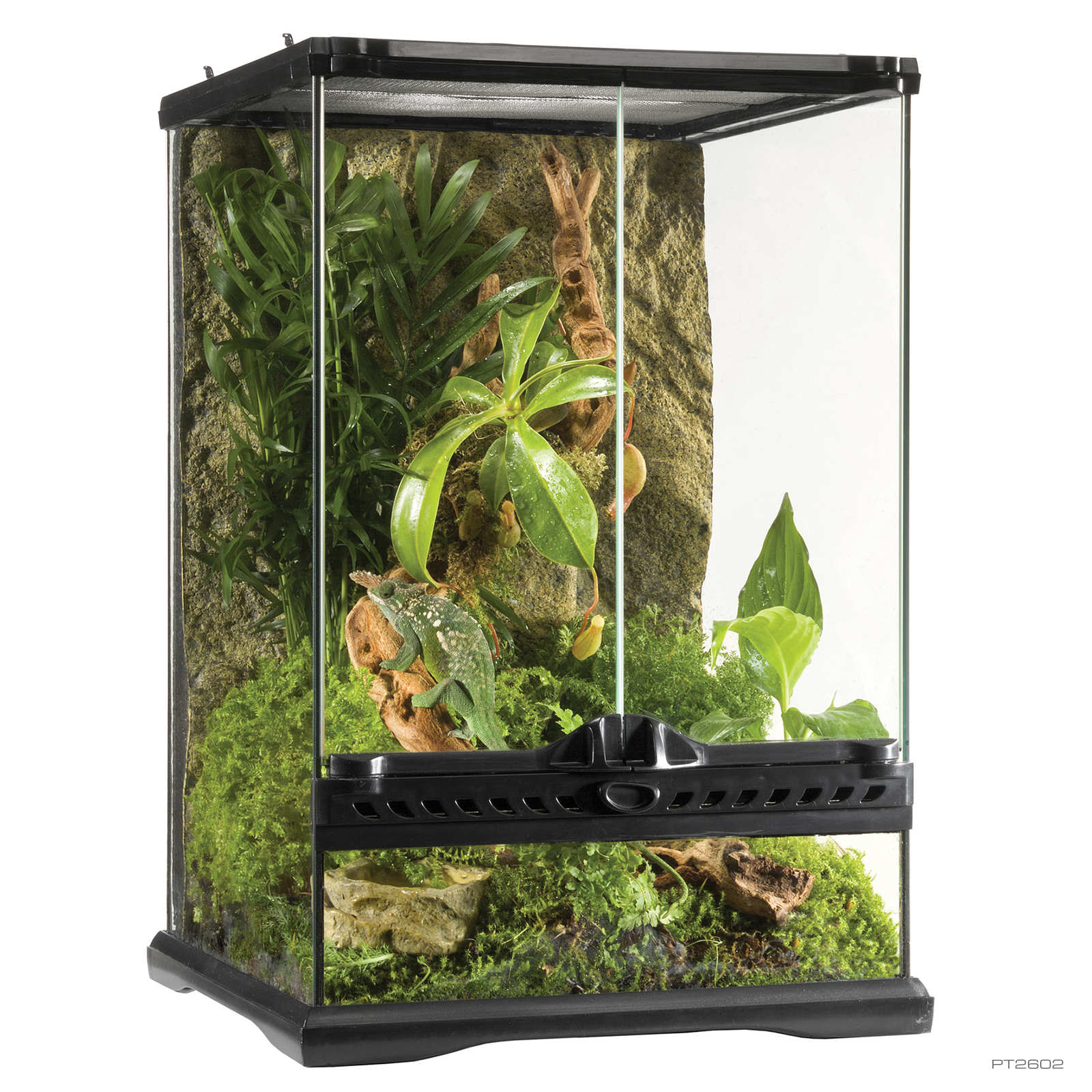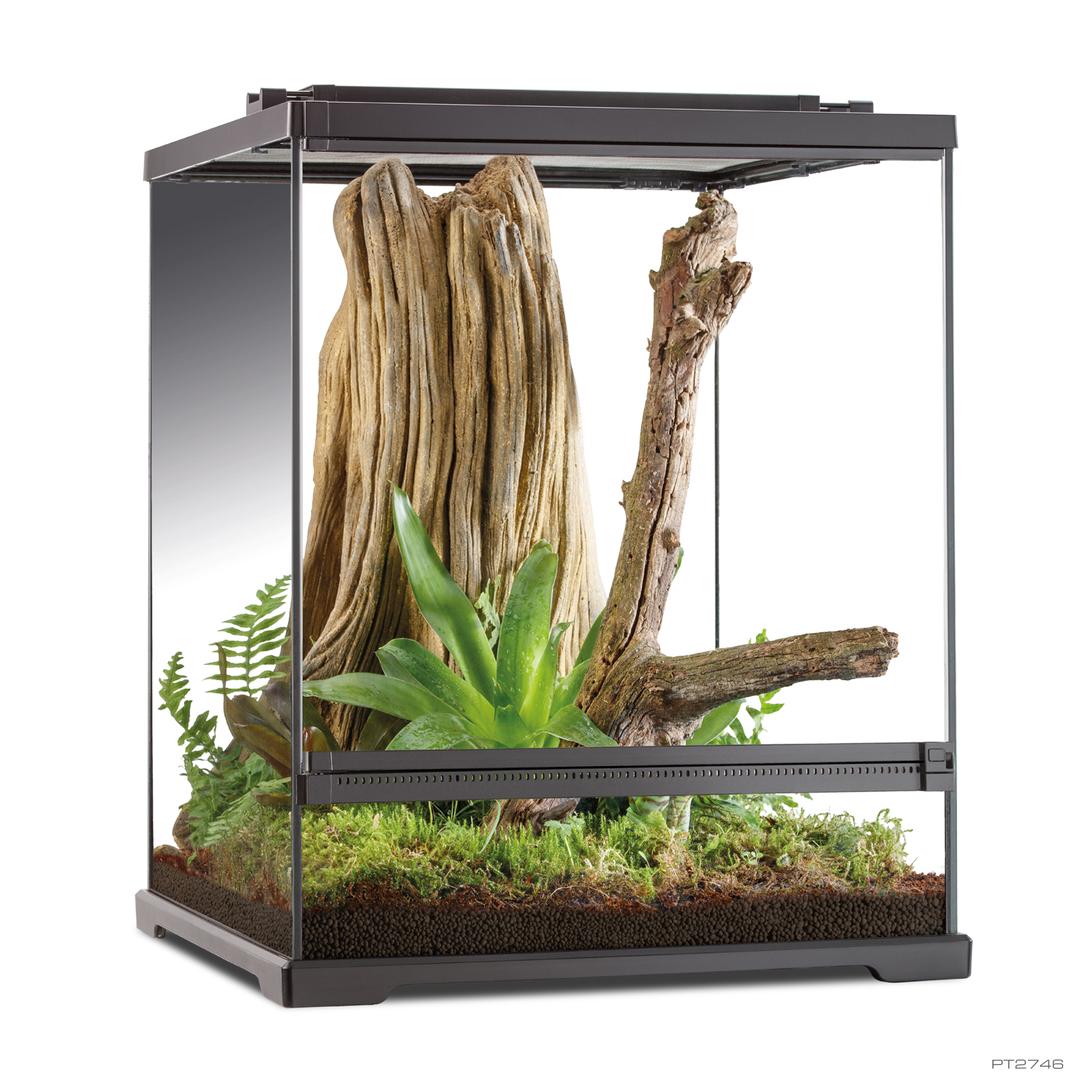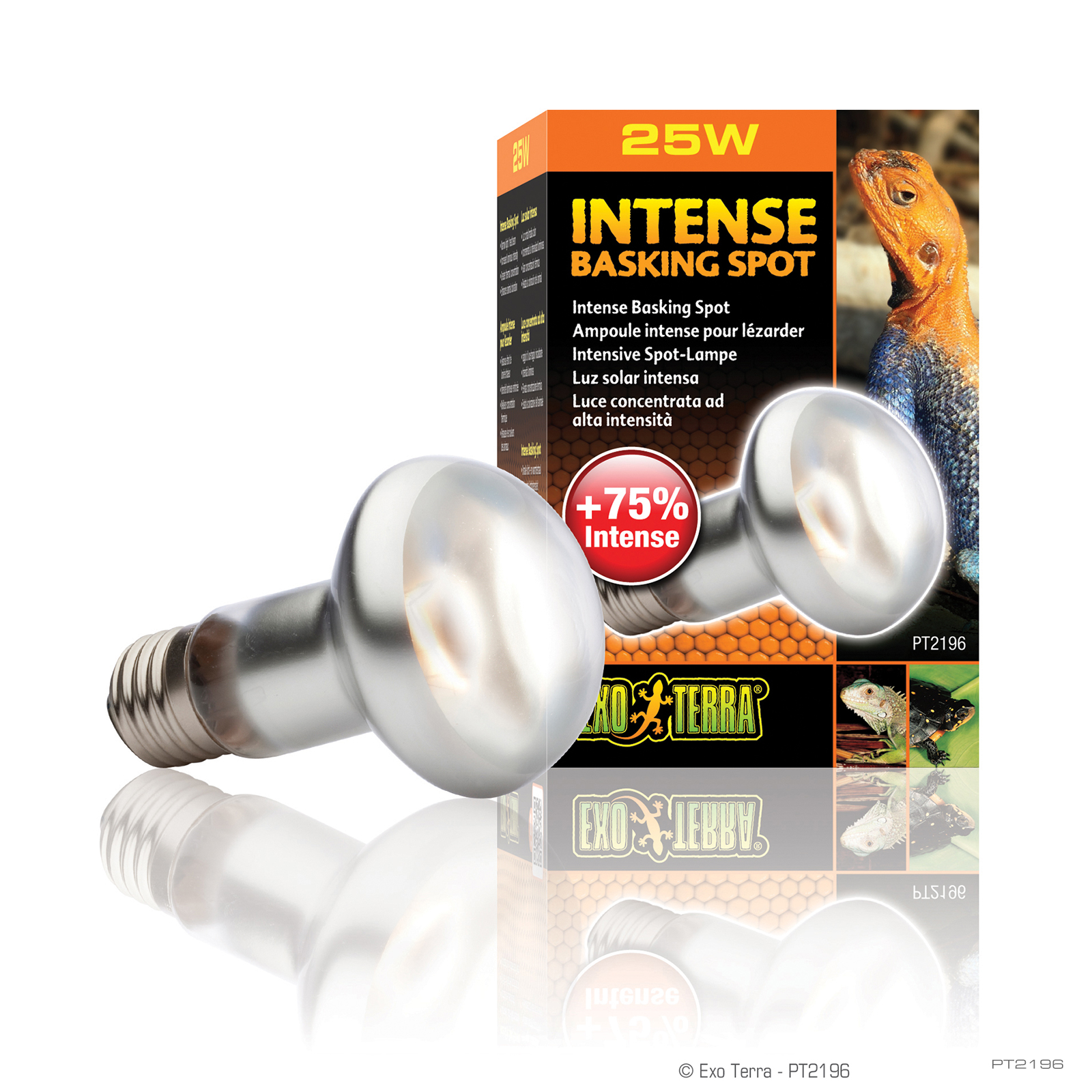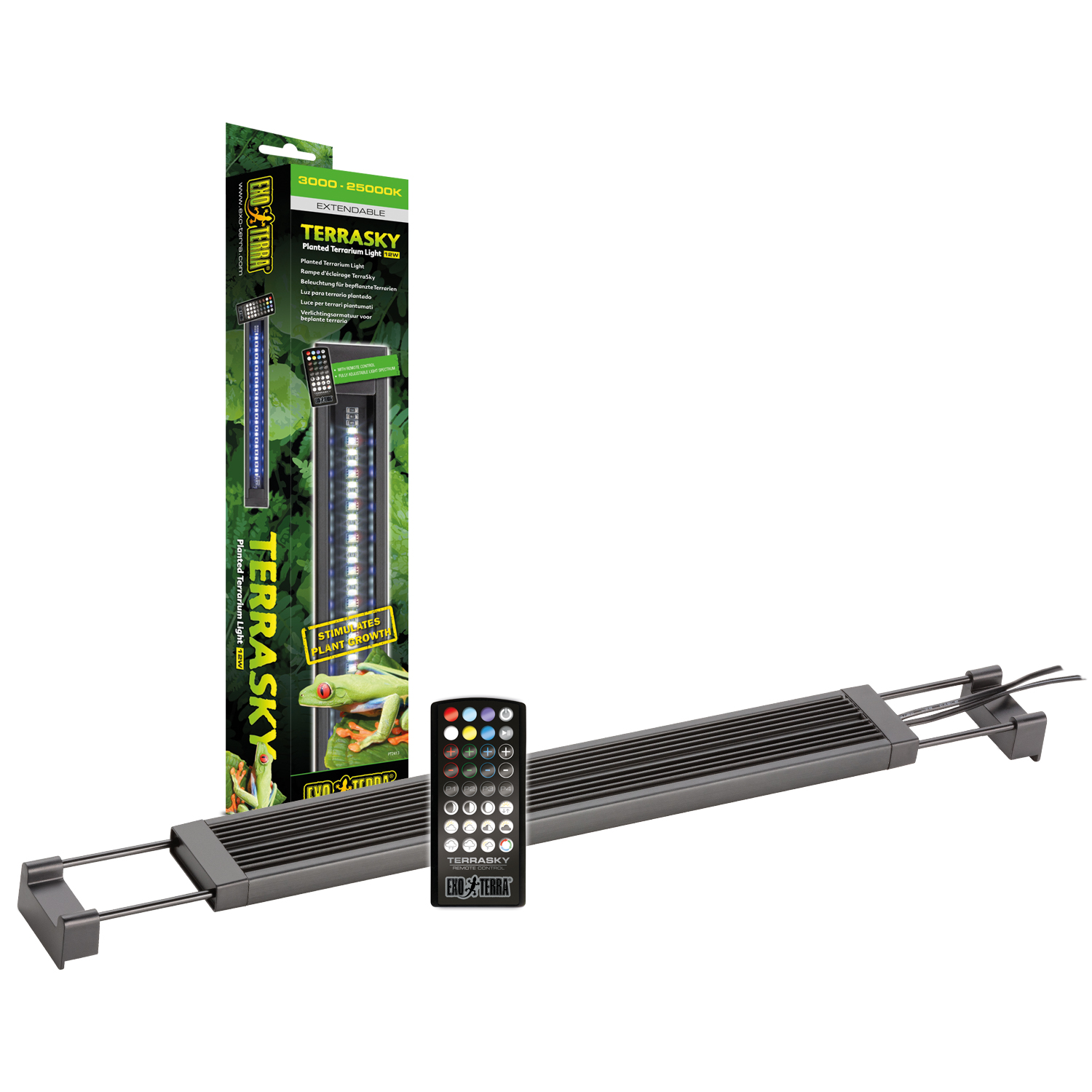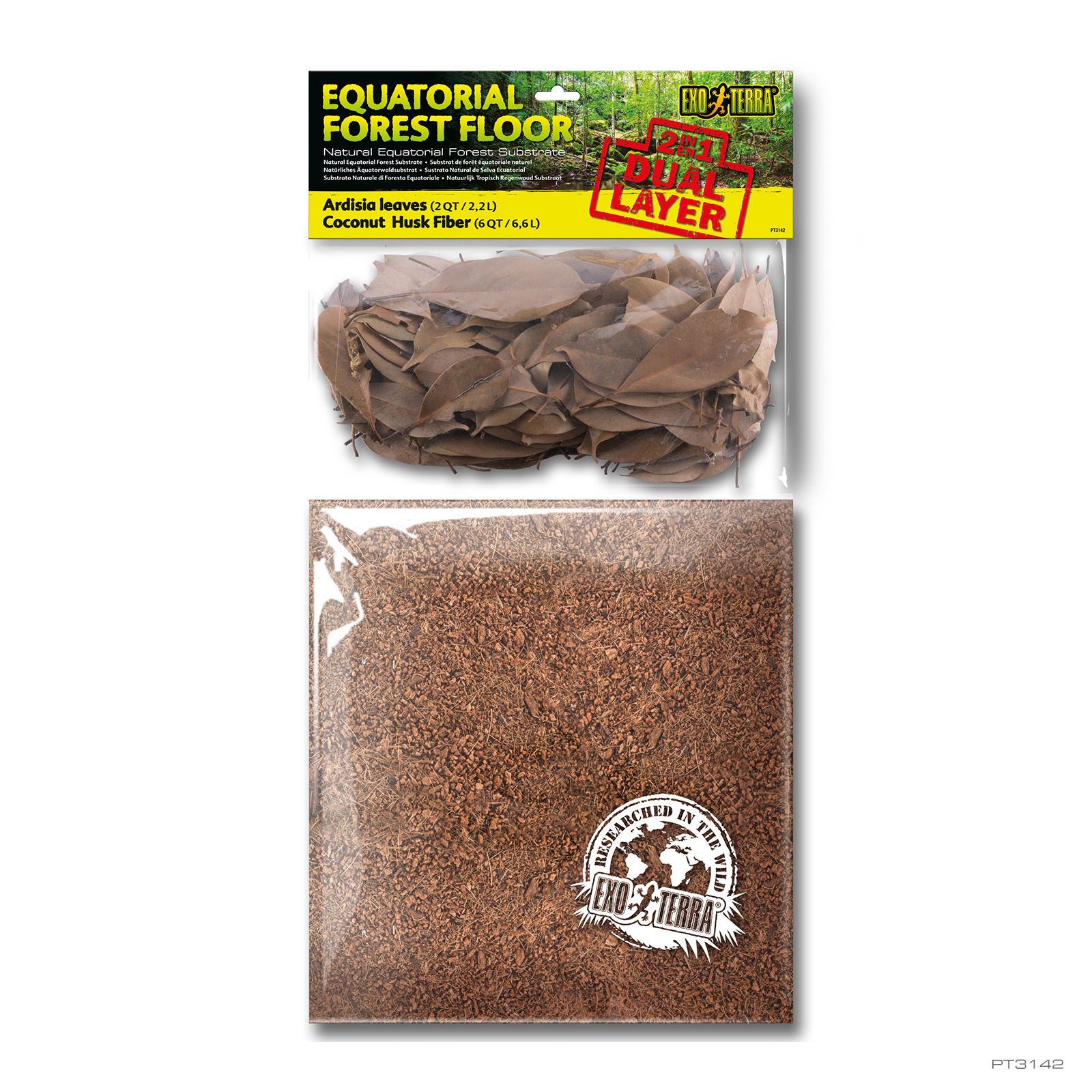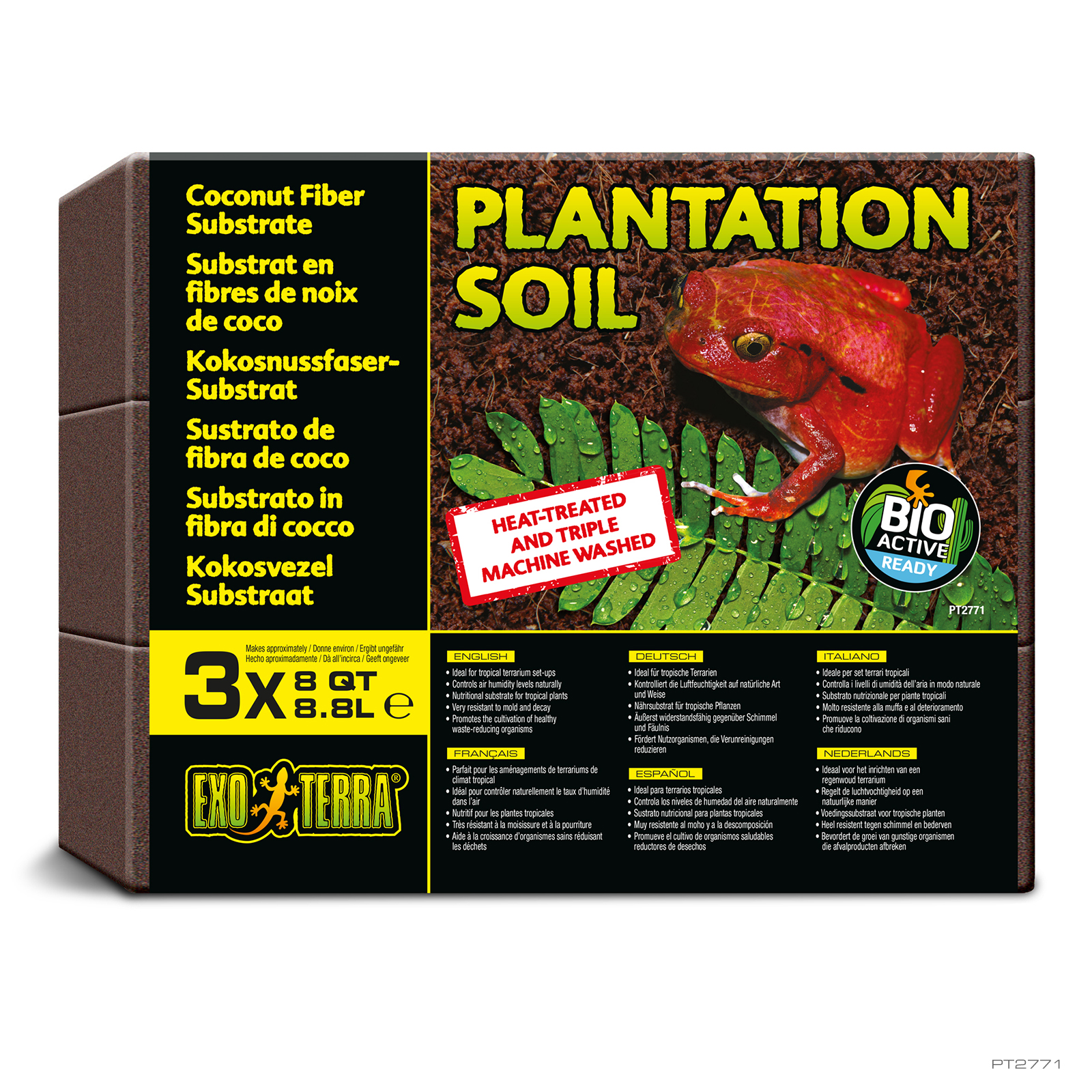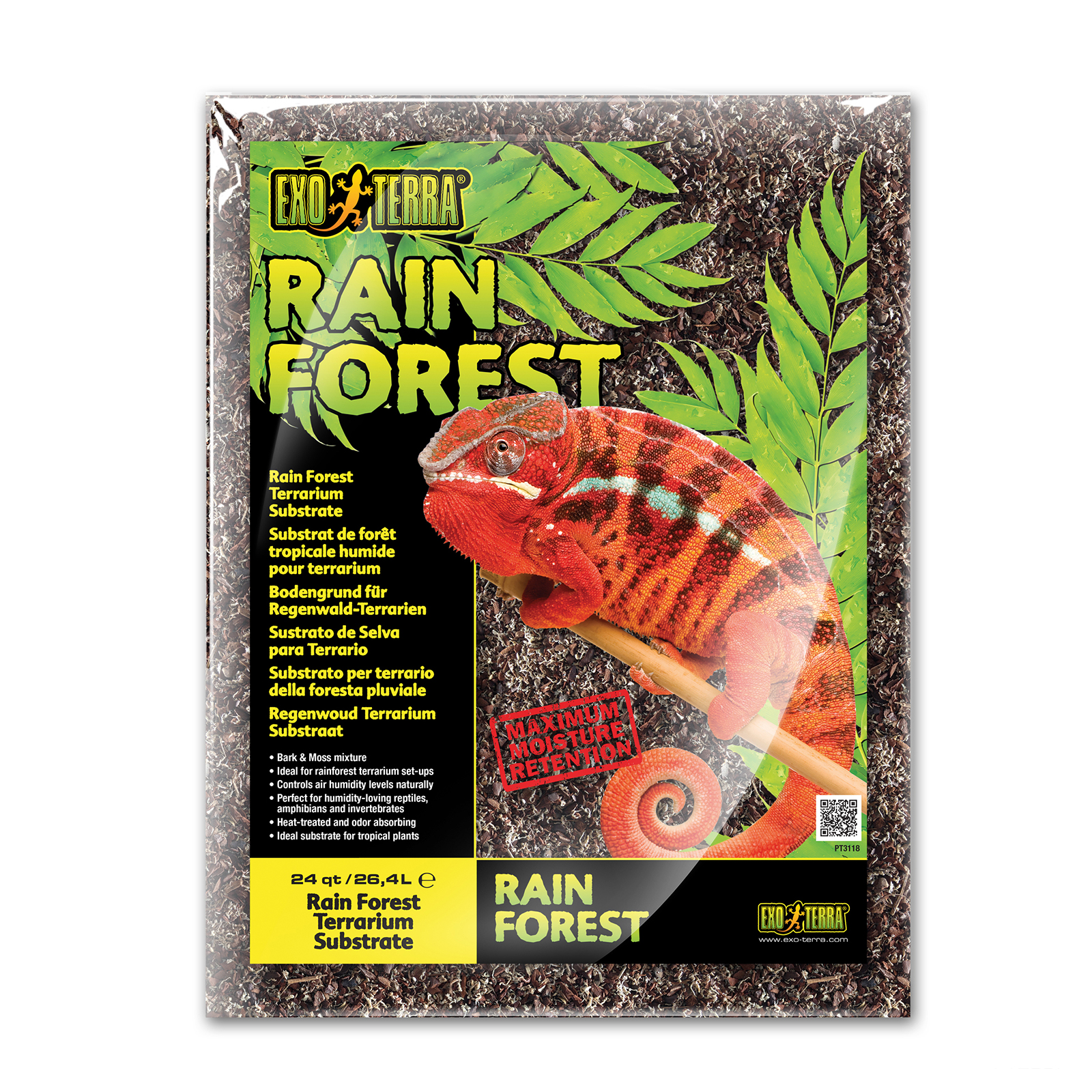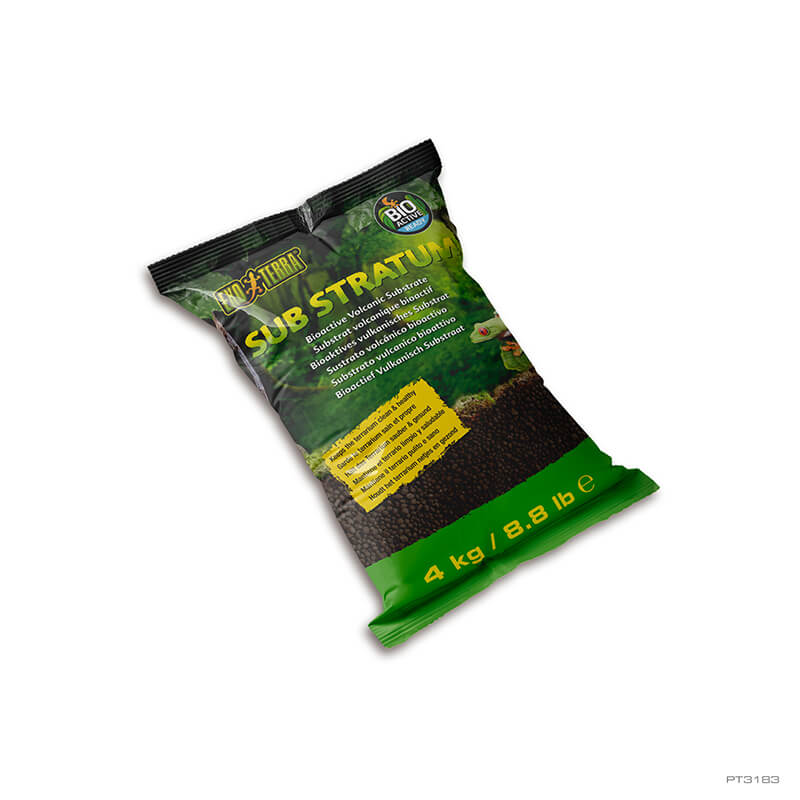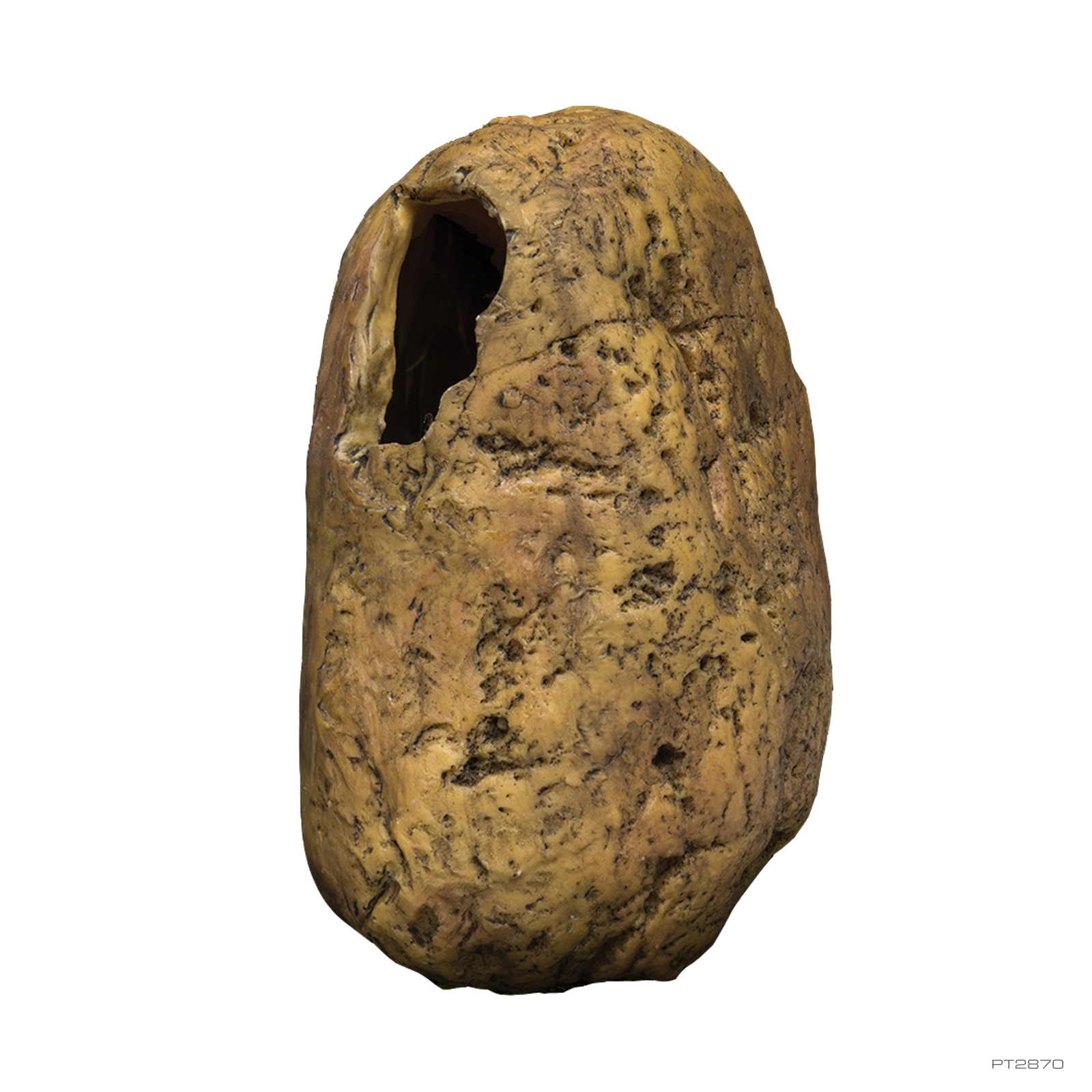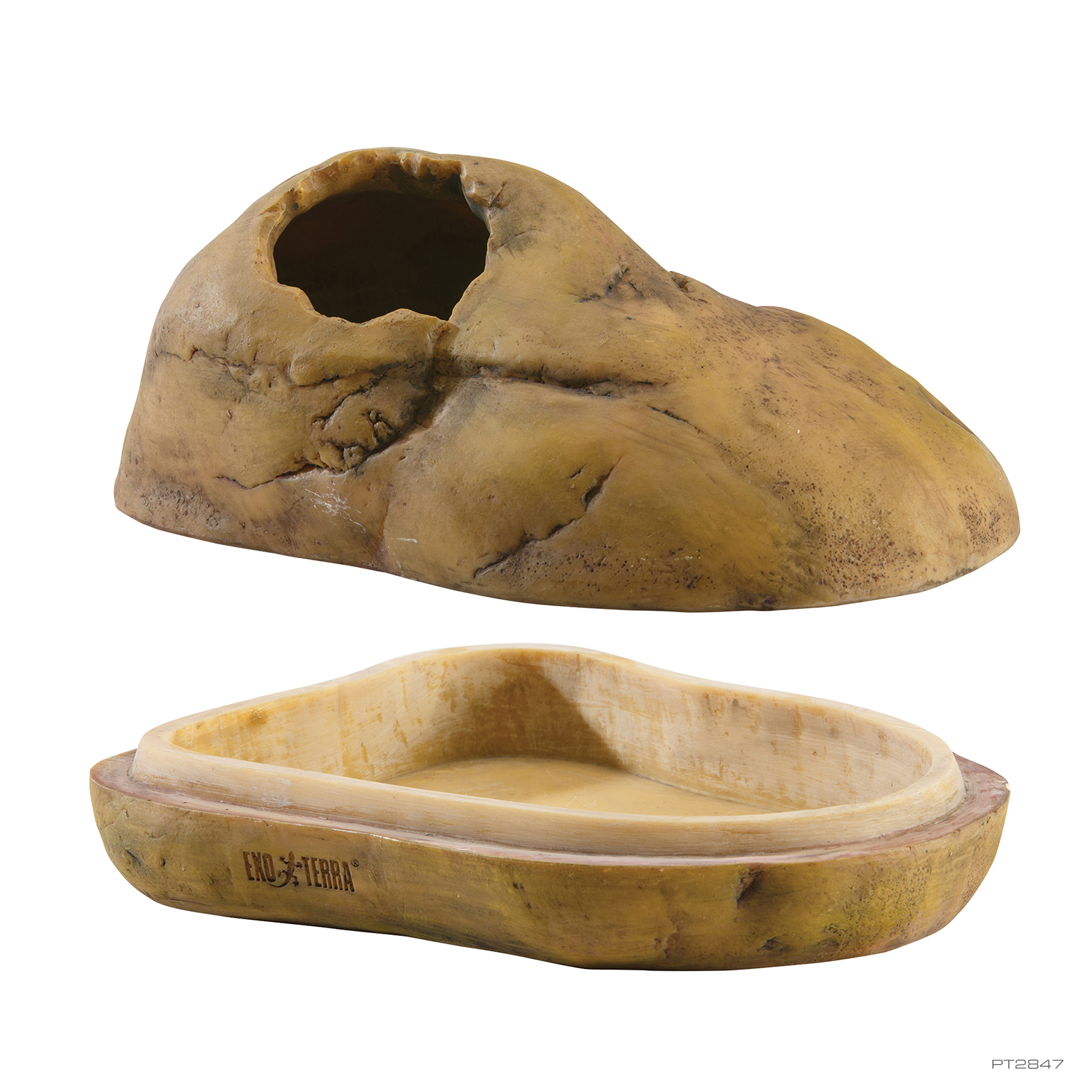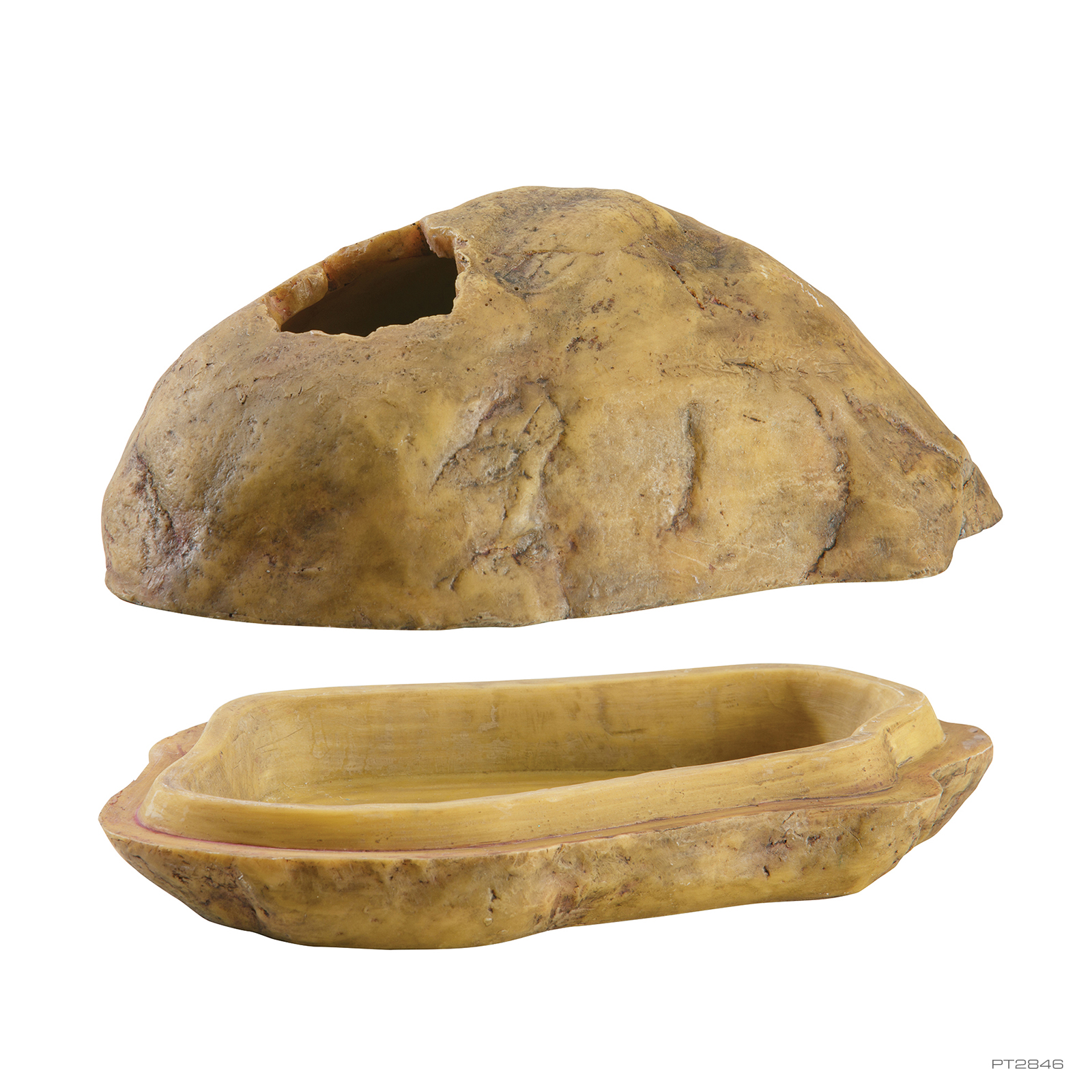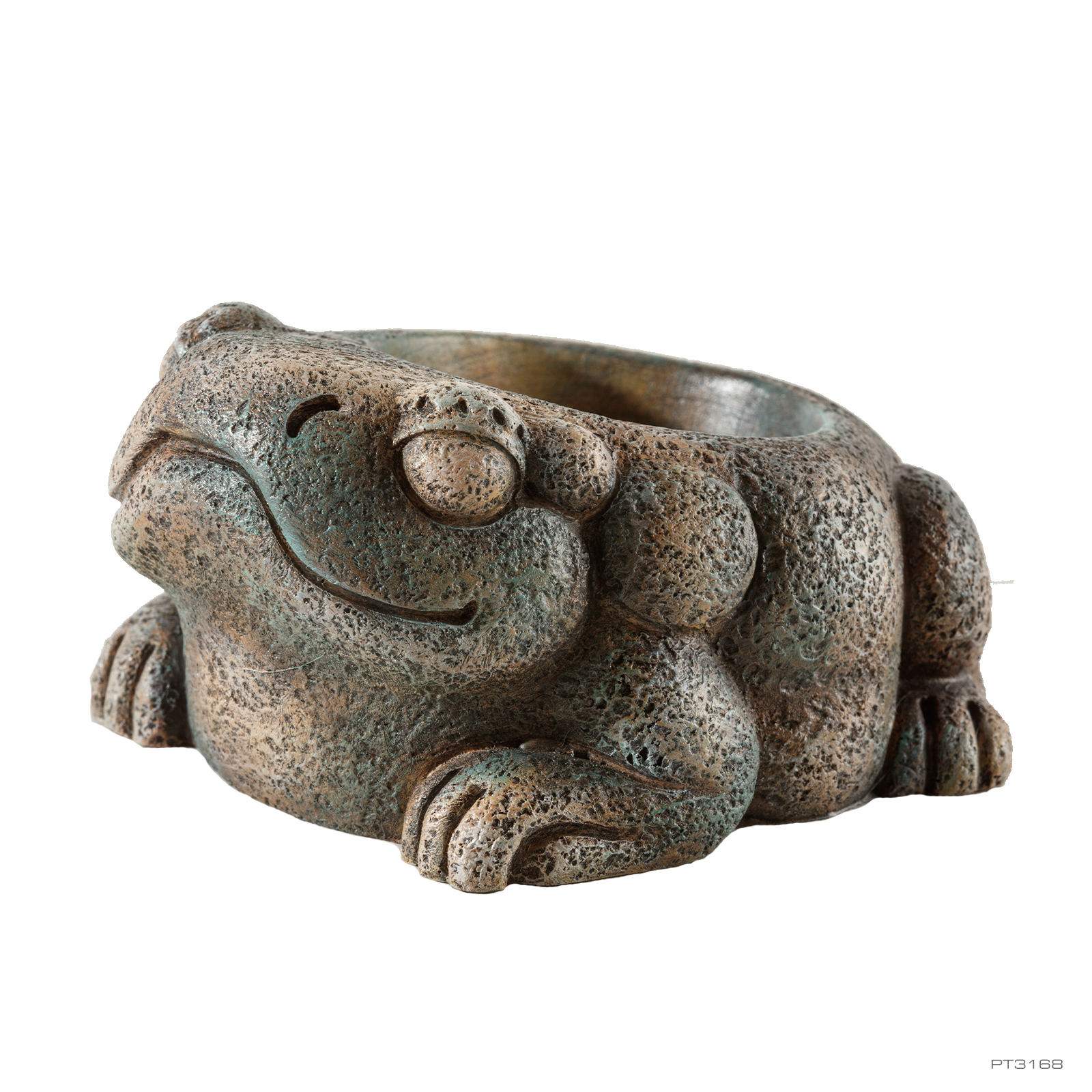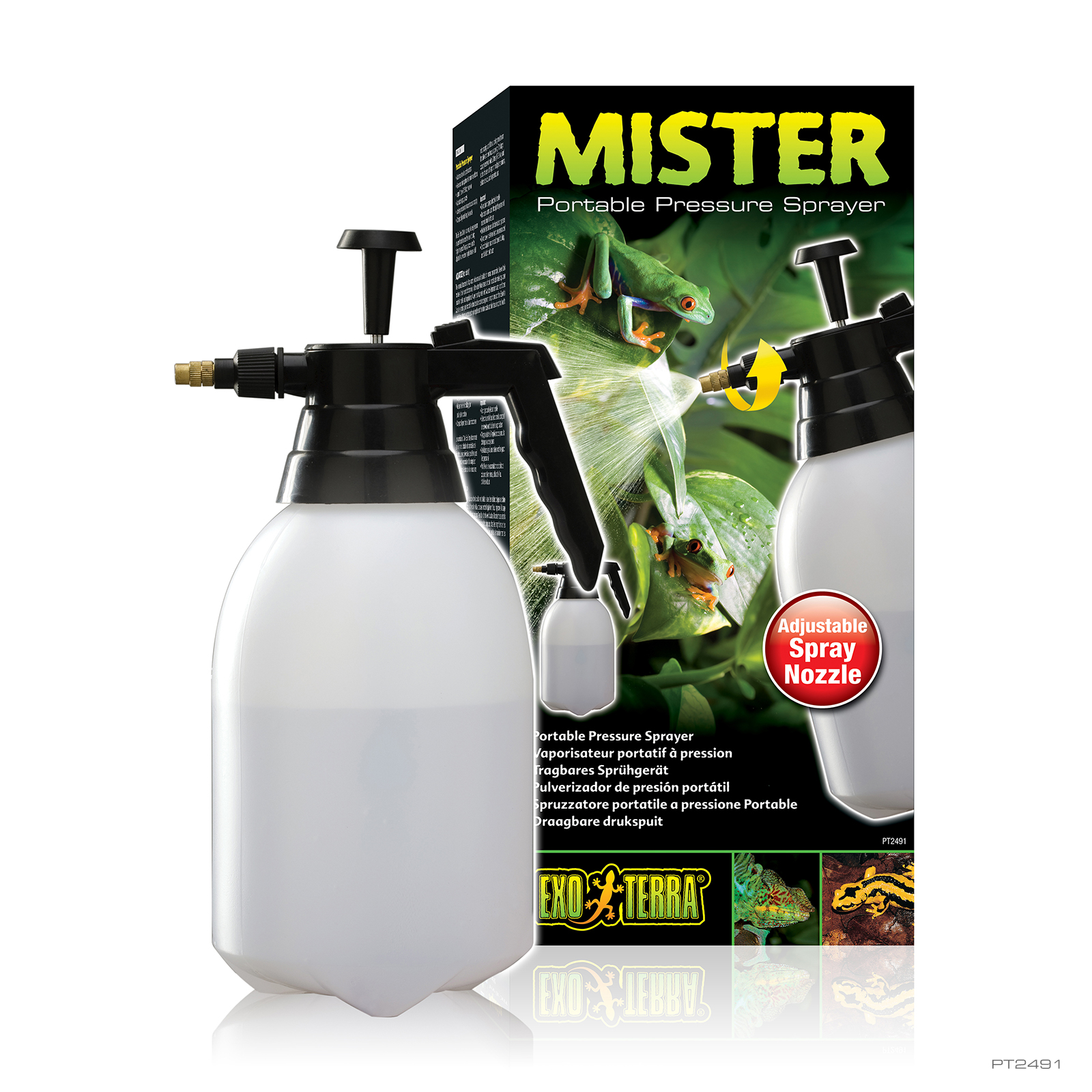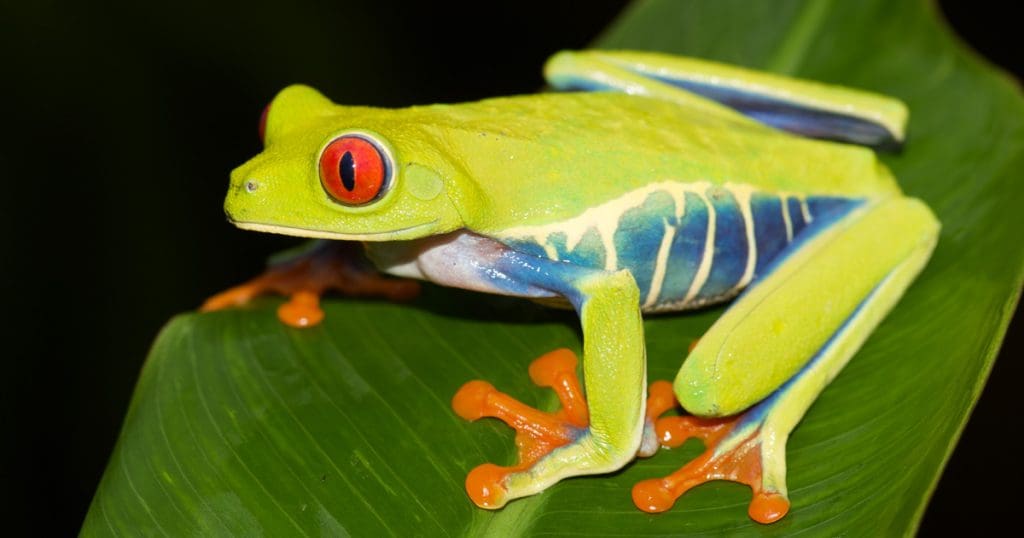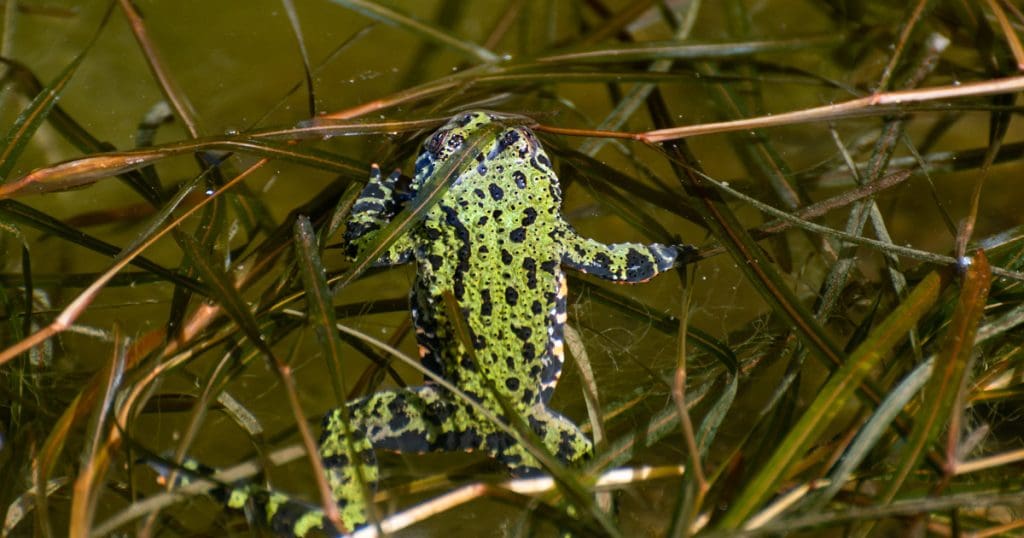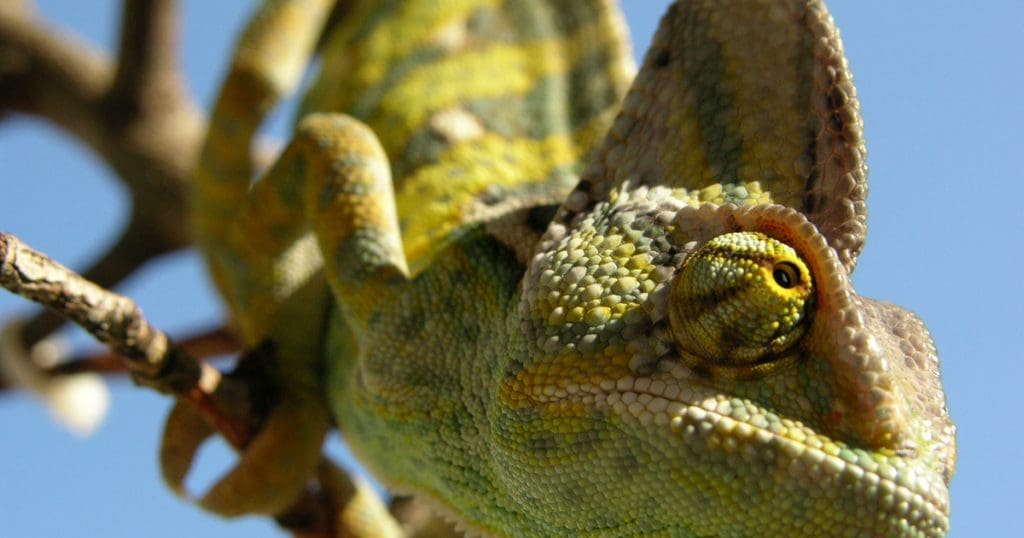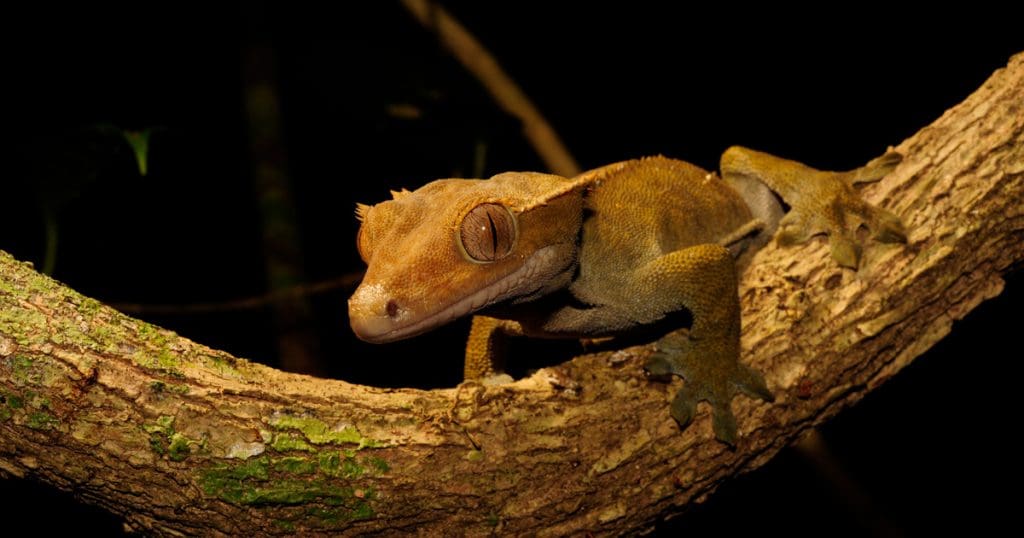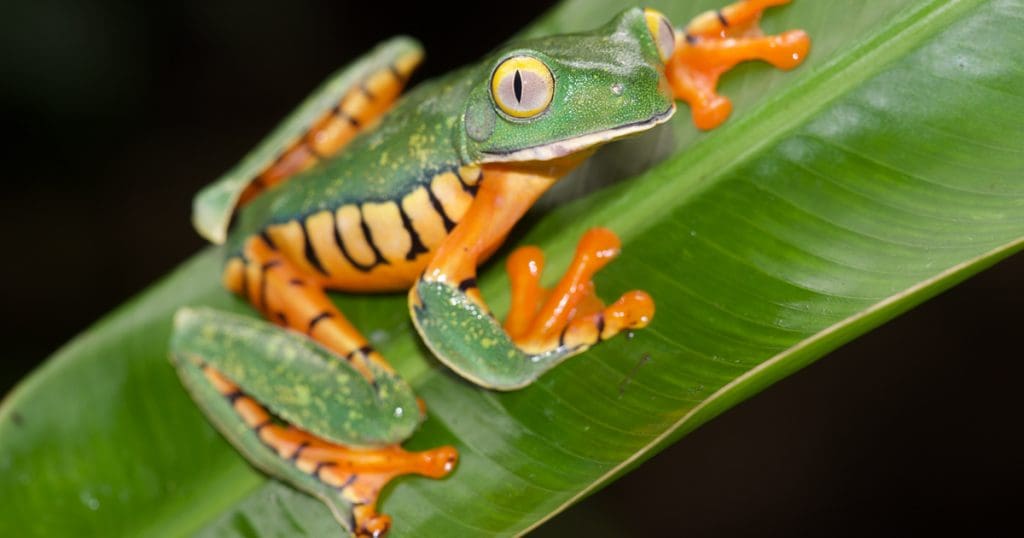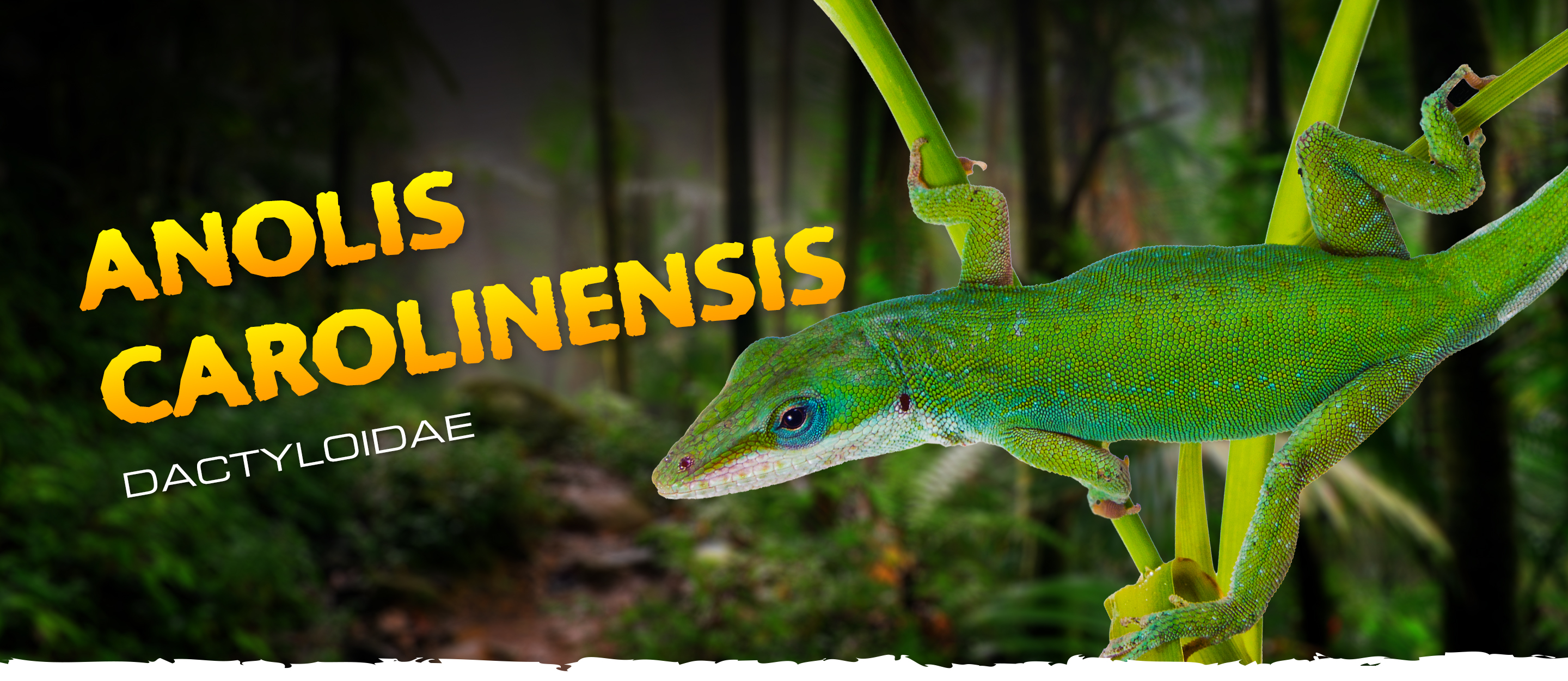
Anolis carolinensis


Green Anole
Green Anoles are native to the Southeastern United States, but have also been introduced to Hawaii, Ogasawara Islands of Japan, Cuba, the Bahamas, and Guam. Green Anoles are diurnal, primarily arboreal, iguanid lizards of the Genus Dactyloidae. Green Anoles mostly inhabit trees and shrubs in tropical & subtropical evergreen forests, but can just as well be found in open grassland with only a few trees, and even in rural and urban areas.
With their changing base color from brown to vivid green, their reddish-pink colored dewlap and their interesting displaying behaviour, these terrarium inhabitants rank among the most popular and easiest to keep beginner reptiles.
Green Anoles are a fairly social species and are best enjoyed when kept in small groups of 1 male with 3 or more females. The interaction between the animals in these small groups increases the viewing pleasure but also stimulates their mating behavior.
Green Anoles have been captive bred in the USA and Europe for more than 30 years. Green Anoles are available as captive bred specimen as well as wild-caught specimen using sustainable ranching and size-selective harvesting.

History
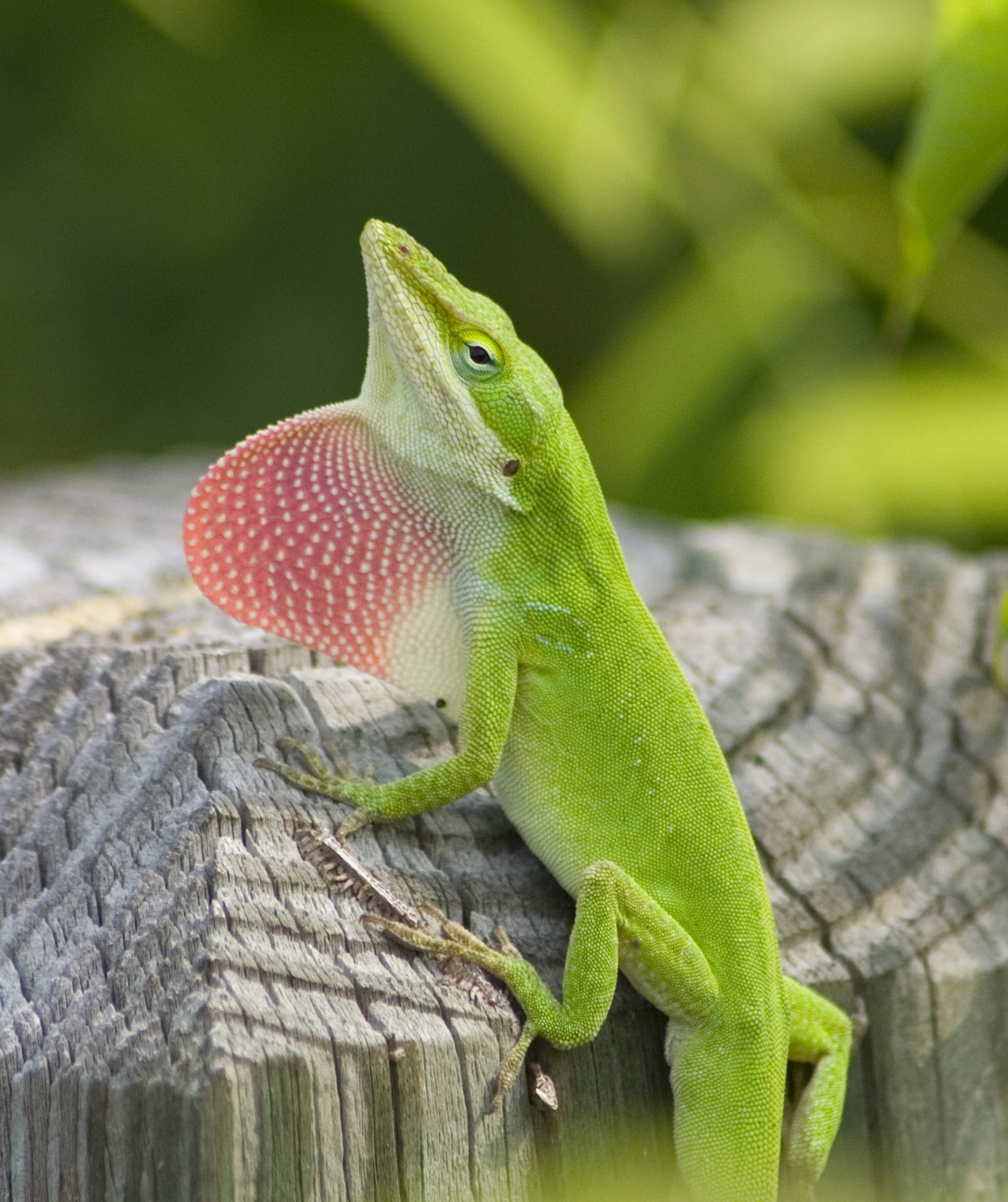
The Green Anole was first scientifically classified by the German Zoologist and Botanist, Friedrich Siegmund Voigt, as Anolis carolinensis in Cuvier`s Das Thierreich, geordnet nach seiner Organisation: als Grundlage der Naturgeschichte der Thiere und Einleitung in die vergleichende Anatomie, Vol. 2: 71, in 1832.
In 1654, Du Tertre already mentioned that the name Anolis, or Anaoli was used in a local Carib language to describe a lizard, but later it was concluded that this lizard was an Ameiva, not an Anolis. The actual Carib name for an Anolis was Oulléouma, and the illustrations in Du Tertre's where labelled "gobe-mouche" or "fly-catcher".
In 1802 François Marie Daudin, a French Zoologist, proposed to use the Genus Anolis for several small species of saurians from diverse colonies of South America in his "Histoire naturelle, générale et particulière des reptiles (Natural History of Reptiles) (8 volumes) in 1802–1803".
The specific epithet "carolinensis" is a latinized name of the state Carolina (North and South) in the Southeastern region of the United States, where the Green Anole was first described from.
Characteristics
Green Anoles belong to the family Dactyloidae in the Genus Anolis.
Green Anoles are small to medium sized, slender lizards. Of the adult size of 6" to 8" or 15-20cm, only approximately 35% belongs to the body length, the remaining 65% consists of the tail. Typically, males range between 7" to 8" or 18 to 20cm, while females remain smaller with adult sizes between 6" to 6.5" or 15 to 17cm.
Both males and females may vary their dorsal base color from a vivid green to grayish-brown to even dark brown. Although their color change is not as pronounced as in chameleons, these tiny anoles can change their base color from vivid green to brown, and all shades in between, in no time. The belly and lips in both sexes are a creamy-white. Male Anoles typically show pronounced shades of blue on their eyelids, and sometimes even on a some scales on the head part. Females mostly show a pronounced light creamy-white dorsal line running from the neck region down to the tail base.
Also a typical sexual dimorphism is the dewlap that males use to impress females while courting as well as to scare away intruders from their territory. The male's dewlap is huge, and typically reddish-pink color, whereas the female's dewlap, which they hardly ever display, is about 1/3rd of the size and creamy-white to very pale pink. Males also sometimes have a more or less developed ridge in the neck region, which they display together with the dewlap while head-bobbing, while defending their territory.
Green Anoles can switch their dorsal color from green to a dark brown due to a melanophore stimulating hormone (MSH). The Melanophores with their pigmentary organelles, and the Iridophores using reflecting platelets to adjust the way they reflect light, are responsible for the color changes.
Green Anoles do not only have the ability to change color, they also have the ability to move their eyes independently. Although these chameleon-like abilities are not as outspoken as seen in the actual Chamaeleonidae, Green Anoles are often referred to as "American Chameleons".
Green Anoles are perfectly adapted to their arboreal lifestyle. The combination of adhesive toe pads and tiny, but effective, claws makes Green Anoles one of the best climbing acrobats among reptiles. Their toe pads they have adhesive lamellae comparable to the ones seen in geckos. With the help of their claws and adhesive toe pads, Anoles can move easily and rapidly on the small branches, large leaves or tall grasses they live in, but even vertically oriented walls of houses, fence poles and even very smooth surfaces like glass form no obstacle.
Green Anoles can reach sexual maturity at the young age of 8-9 months old. We do however recommend that you wait until the animals are between 12 to 14 months of age, before mating them, to ensure that the animals are physically strong enough to handle the arduous process of egg development and egg laying.
Distribution
Green Anoles are endemic to the tropical & subtropical evergreen forests of Florida, Georgia, South Carolina, North Carolina, Southern Tennessee, Alabama, Mississippi, Louisiana, Southern Arkansas, Southeastern Oklahoma and Eastern Texas as well as in North-Eastern Mexico. The current range however is much wider, as this species has also been introduced to Hawaii, the Ogasawara Islands of Japan, Cuba, the Bahamas, Micronesia and Guam. There is even a report stating that the Green Anole was sighted on Tenerife in the Canary Islands.
In the Wild
Green Anoles are diurnal reptiles with a primarily arboreal lifestyle, but will also dwell on the floor to catch food insects, to deposit their eggs or to hide-out during the colder season. Because of their arboreal lifestyle, they require tall terrariums to accommodate plants and climbing structures. Taller terrariums will also allow for more stratification to enrich the environment and create a visually more appealing display.
Green Anoles are a fairly social species and are best enjoyed when kept in small groups of 1 male with 3 or more females. The interaction between the animals in these small groups increases the viewing pleasure but also stimulates their mating behavior.
We do not recommend to keep 1 male Green Anole with 2 female Green Anoles, as this might lead to territorial behavior of the dominant female. Combining 1 male Green Anole with 3 or more female's reduces the impact the dominant female can force onto a single individual female in the terrarium.

In the Terrarium
Green Anoles are diurnal reptiles with a primarily arboreal lifestyle, but will also dwell on the floor to catch food insects, to deposit their eggs or to hide-out during the colder season. Because of their arboreal lifestyle, they require tall terrariums to accommodate plants and climbing structures. Taller terrariums will also allow for more stratification to enrich the environment and create a visually more appealing display.
Green Anoles are a fairly social species and are best enjoyed when kept in small groups of 1 male with 3 or more females. The interaction between the animals in these small groups increases the viewing pleasure but also stimulates their mating behavior.
We do not recommend to keep 1 male Green Anole with 2 female Green Anoles, as this might lead to territorial behavior of the dominant female. Combining 1 male Green Anole with 3 or more female's reduces the impact the dominant female can force onto a single individual female in the terrarium.
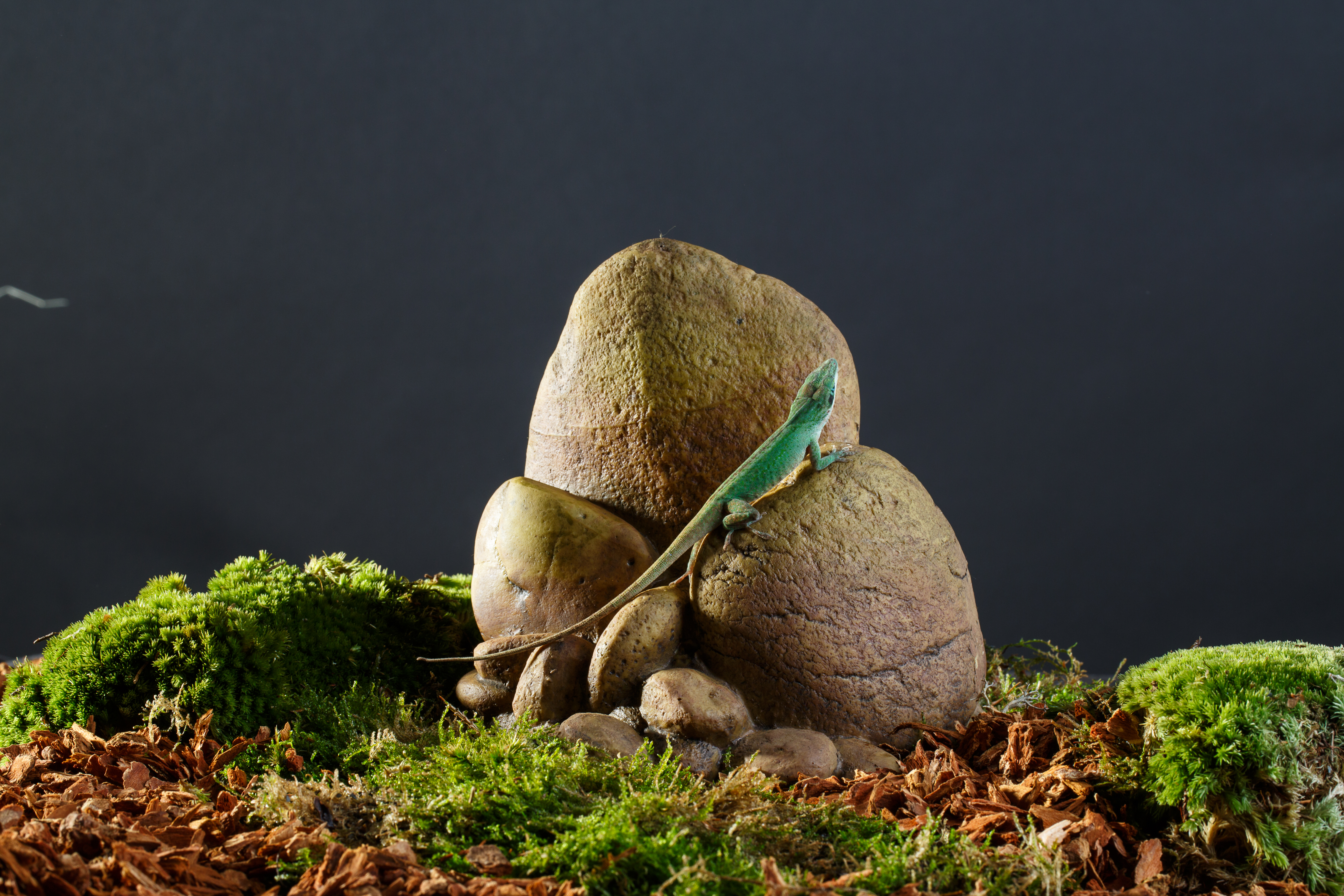
Terrarium
Green Anoles thrive best in vertically oriented, well ventilated terrariums like the Exo Terra® Natural Terrariums or the Exo Terra® Tree Frog Terrariums. Also the Exo Terra® Screen Terrariums work well, especially for outside use during sunny days, since there's no stagnant air or built-up of heat.
Exo Terra® Natural Terrariums, designed by European herpetologists, are the ideal arboreal enclosures for Green Anoles. These glass terrariums feature front opening doors, allowing easy access for maintenance and feeding and a unique double ventilation system with full screen stainless steel top. The full screen stainless steel top allows ultraviolet rays from UVB lights to penetrate deep inside the enclosure. The dual ventilation system allows sufficient airflow during the day, while it facilitates to keep the relative humidity at an optimal level during the night. In the back of the screen cover are 5 closable wire or tube inlets on both sides to facilitate the installation of powered accessories like waterfall pumps, filters, the Exo Terra's Monsoon, etc.
The Exo Terra® Natural Terrariums Mini/Tall, Small/Wide and Small/Tall provide good ventilation and adequate climbing space to raise groups of hatchling or young Green Anoles, or to maintain groups of 1 adult Green Anole male with one or more females:
PT2602 – Natural Terrarium - Mini/Tall – up to 6 hatchling or 4 young Green Anoles or 1 adult male and 1 adult female Green anole (WxDxH: 30 x 30 x 45 cm / 12” x 12” x 18”)
PT2605 – Natural Terrarium - Small/Wide – up to 12 hatchling or 6 young or 1 adult male with 3 adult female Green Anoles (WxDxH: 45 x 45 x 45 cm / 18” x 18” x 18”)
PT2607 – Natural Terrarium - Small/Tall – 1 adult male and up to 6 adult female Green Anoles (WxDxH: 45 x 45 x 60 cm / 18” x 18” x 24”)
The Exo Terra® Tree Frog Terrarium even comes with a built-in drain and tap valve which allows you to easily drain out excess spray water. This drain will come in handy when simulating the rainy season to induce mating behaviour in your frogs. The single front opening door allows maximum viewing pleasure and provides easy access for maintenance and feeding. A push-button lock keeps the terrarium secure and can even be outfitted with an optional lock to prevent unwanted opening. The hinged cover can be locked and unlocked with a single button and can be fully opened. A clear glass panel in the front ensures maximum visible light penetration and a stainless-steel ventilation strip in the back guarantees optimal ventilation. The patented dual ventilation system keeps the single front glass door free of condensation, even in humid conditions. It creates a natural upward flow of air to ensure optimal and healthy conditions. Excess heat is dissipated through the top mesh and prevents heat from accumulating, creating temperature gradients in the terrarium. The screen mesh allows UV and infrared penetration when these bulbs are required. Four self-closing inlets for wire/tubing in the back facilitate the installation of powered accessories like waterfall pumps, filters, the Exo Terra's Monsoon, etc. The inside front of the lid has a Monsoon Nozzle mounting point on each side of the terrarium. The bottom part of the terrarium is waterproof once the tubing, elbow-connector and tap valve are connected to the drain. The drain allows hassle free water changes and excess water removal.
The Exo Terra® Tree Frog Terrarium and Dart Frog Terrarium provide good ventilation and adequate climbing space to raise groups of hatchling or young Green Anoles, or to maintain groups of 1 adult Green Anole male with one or more females:
PT2745 - Dart Frog Terrarium - up to 12 hatchling or 6 young or 1 adult male with 3 adult female Green Anoles (WxDxH: 45 x 45 x 45 cm / 18" x 18" x 18")
PT2746 - Tree Frog Terrarium - 1 adult male and up to 6 adult female Green Anoles (WxDxH: 45 x 45 x 60 cm / 18" x 18" x 24")
The Exo Terra® Screen Terrarium is a perfect habitat for arboreal reptiles that are sensitive to stagnant air. The non-restricted airflow provides optimal ventilation while minimizing odors and fungus growth in your reptile’s habitat. The screen design provides a broader temperature gradient, which helps your Green Anoles to regulate their body temperature more effectively and prevents overheating. The aluminum screen mesh allows ultraviolet rays from UVB lights or the sun to penetrate deep inside the enclosure. The substrate tray allows you to place a small layer of substrate to absorb spray water and increase humidity levels. The substrate tray can easily be removed from the enclosure through the swiveling bottom door. The sturdy latches add stability to the enclosure and keep your Green Anoles safe & secure.
The Exo Terra® Screen Terrariums Small/Tall and Small/X-Tall provide good ventilation and adequate climbing space to raise groups of hatchling or young Green Anoles, or to maintain groups of 1 adult Green Anole male with one or more females:
The set-up can be a simple “sterile-type set-up" with an Exo Terra® Moss Mat, a Dripper Plant with a Water Dish, a potted live plant in combination with some Exo Terra® hanging plants, and some branches and Exo Terra® Vines as climbing space. Or you can offer your Green Anoles a more natural, “bio-active type set-up” by replacing the Exo Terra® Moss Mat with a Tropical Forest floor created by a bottom layer of Sub Stratum, a middle layer of Plantation Soil, topped with Ardisia leaves (Equatorial Forest Floor).
Never house 2 male Green Anoles together in one terrarium as they tend to be very territorial.
DISCLAIMER In regards to the pet species and number of specimens to be kept in a terrarium, always comply with the species specific Rules and Regulations in your Country of residence.
DISCLAIMER The terrarium should be placed in a room receiving only indirect light from windows. Do not place the Terrarium near a window where it can receive direct sunlight, as this could cause the terrarium to overheat and stress or kill your Green Anoles.
Lighting
Green Anoles are diurnal, meaning they’re active during daylight. Since Green Anoles are heliophilic, meaning they are attracted to sunlight, we have to provide them with a combination of sufficient visual light, UVA, UVB and Heat rays during daytime.
A 12-hour day/night cycle is an adequate photoperiod for the healthy all-year-round keeping of your Green Anoles. The more natural approach, and to induce breeding, is to provide higher temperatures with 13 hours of daylight and 11 hours of nighttime during the rainy season, and reduce the daylight cycle to 11 hours daylight and 13 hours nighttime during the dry season.
The lighting for Green Anoles consists of 2 parts. A very important role for the illumination of heliophilic Anoles is reserved for the visible light in combination with UV radiation. The other part of the "lighting" is actually a combination of "light & heat" in the form of incandescent bulbs. Anoles do not recognise non-visible heat sources like ceramic heat emitters, heat cables, heat mats, etc.
Proper UVB Lighting is VITAL for your Green Anoles! It is very important that the upper ⅓ of the terrarium is reserved for proper basking spaces at different levels, so the Anoles can actively thermoregulate and UV-regulate by targeted basking. The correct UVB wavelength assures that provitamin D3 (7-Dehydrocholesterol) can be converted into pre-Vitamin D3. Once this is formed, the heat rays will then provide the correct temperature for the thermal isomerisation into actual Vitamin D3. Without the combination of light, heat and UVB, your Green Anoles cannot produce the necessary Vitamin D3 to absorb calcium from their food. A major dietary problem in captive reptiles is the low assimilation of calcium from their daily food. Calcium is vital for bone growth and maintenance, muscle function, and many of the body’s most important metabolic functions.
There are various solutions to offer your Green Anoles quality lighting. You can either go for all-in-one bulbs like the Exo Terra® Solar Glo or Solar Ray, which provide optimal levels of UVA, UVB, visual light and heat all in one bulb! These bulbs deliver a consistent spectrum, which closely approximates that of natural sunlight, contributing to the animal’s overall wellbeing. The combination of the correct UVB wavelength and heat enables the animal to produce its own vitamin D3 for proper calcium absorption and prevents metabolic diseases (e.g., MBD). The powerful light output and balanced UV rays stimulate appetite and breeding behavior, while improving the physiological health of reptiles.
Or you can choose for a combination of fluorescent UVB lighting (like the Reptile UVB150/200 linear or Reptile UVB150/200 compact) in combination with an incandescent heat bulb (like the Exo Terra® Intense Basking Spot or Halogen Basking Spot).
In order to increase the overal visible light, the Exo Terra® TerraSky Planted Terrarium Light is the ideal LED lighting solution for planted setups and bioactive terrariums. The high intensity and enhanced penetration ensure that the light reaches all layers of the terrarium, resulting in sustained lush plant growth. Orchids, Bromeliads, Tillandsias (air plants), carnivorous plants, mosses and lichen all thrive under the TerraSky Planted Terrarium Light’s strong Photosynthetic Active Radiation (PAR). The 120-degree light dispersion provides a nice even illumination and covers the complete area to avoid dark spots.
Heating
Monitoring
Green Anoles require a specific temperature range, both during daytime and nighttime, to thrive (see “Heating”). They also do best at a moderate relative humidity of between 60-70% during daytime and over 80% at night.
Use the Exo Terra® Digital or Analog Thermometers and Hygrometers to help you monitor the terrarium conditions and adjust the temperature and relative humidity to meet the needs of the animals. It is best to always use 2 Thermometers, one placed at the coolest end of the terrarium and the other one placed at the warmer end.
For more security and peace of mind, the Exo Terra® Thermostats or Thermostat & Hygrostat will help to prevent overheating and undercooling during hot summer days or cold winter nights. Apart from the temperature, the Exo Terra® Thermostat & Hygrostat will also help keep the humidity at the desired level. With the Exo Terra® Thermostats or Thermostat & Hygrostat you can create a well-controlled heating/humidifying system that allows you to maintain the required temperature and/or humidity conditions similar to those found in your animal's environment.
Substrates
Green Anoles are primarily arboreal and don't bother too much about the kind of substrate used in their housing, except when females need to lay their eggs or when temperature and humidity conditions become unbearable.
The set-up can be a simple “sterile-type set-up" with an Exo Terra® Moss Mat, a Dripper Plant with a Water Dish, a potted live plant in combination with some Exo Terra® hanging plants, and some branches and Exo Terra® Vines as climbing space. Or you can offer your Green Anoles a more natural, “bio-active type set-up” by replacing the Exo Terra® Moss Mat with a Tropical Forest floor created by a bottom layer of Sub Stratum, a middle layer of Plantation Soil, topped with Ardisia leaves (Equatorial Forest Floor).
1. “sterile-type set-up” The Exo Terra® Moss Mat is a convenient substrate choice especially for hatchling and young but also for adult Green Anoles. The Exo Terra Moss Mat is an extremely natural-looking terrarium substrate. Soft, hygienic and absorbent the Exo Terra Moss Mat is easy to use and can be cut to fit any terrarium size. It allows you to perfectly spot-clean the bottom part of the Anole's terrarium for maximum hygiene. Simply rinse clean when soiled or replace as necessary.
2. “bio-active type set-up”
a. The substrate layer can consist of a single layer of Exo Terra® Sub Stratum, Exo Terra® Plantation Soil or a mixture of both, which will provide the benefits of both substrates.
The live bacteria in the Exo Terra® Sub Stratum will activate when the substrate comes in contact with water or waste. The organic matter such as left-over food and animal waste will decompose over time. The absorbing properties of volcanic ash will eliminate odours by trapping the decomposed materials. By mixing the Exo Terra® Plantation Soil with Exo Terra® Sub Stratum, you enrich the substrate with the required minerals like calcium, nitrogen, potassium and phosphorus. It also aids in the water retention capacity and provide adequate air supply to the roots.
b. For advanced drainage and aeration, you can use the multi-layered Bio Drain System. In the Bio Drain System, you use an inorganic bottom drainage layer, like Exo Terra® Bio Drain Substrate or Exo Terra® Sub Stratum, which you cover completely with the non-decomposable Bio Drain Mesh. This will allow proper water drainage and aeration of the substrate layers you will built up on top. The actual substrate layer that will be used for planting can consist of mixture of Exo Terra® Sub Stratum with Exo Terra® Plantation Soil. The multi-layered Bio Drain System with the Sub Stratum and Plantation Soil mix will allow proper drainage and aeration, preventing foul smells often associated with damp soils.
The Exo Terra® Sub Stratum is a natural volcanic soil with live beneficial bacteria. The porous surface and low-density structure allow for excellent drainage and aeration, but it also promotes a flourishing population of beneficial, nitrifying bacteria, creating a self-sustaining, living terrarium ecosystem. The active beneficial bacteria of the soil will decompose biological waste, keeping the terrarium clean and healthy.
The Exo Terra® Plantation Soil is a 100% natural, biodegradable terrarium substrate made from sustainable, ground coconut husk fiber grown on plantations in tropical Asia. The unique hygroscopic properties of this ecological substrate regulate the terrarium’s humidity in a natural way. The unique coir pith used for the Exo Terra® Plantation Soil consists of a mixture of short fibers and coco-peat grain sizes ranging from coarse granules to fine clumps resulting in improved soil drainage and aeration. The improved aeration of the substrate promotes the cultivation of healthy waste-reducing organisms keeping your terrarium fresh and clean.
The substrate should be kept slightly moist, but definitely not soaking wet, at all times. Make sure to offer different gradients of moisture inside the terrarium. Some parts can be kept rather moist while other parts should be kept somewhat drier. Young Green Anoles prefer a somewhat more humid environment compared to adults. Also, try to vary the moisture depending on the season, spray more frequently during the warmer parts of the year. Preferably spray before the lights are switched on, and after they have been turned off.
The Exo Terra® substrates will help maintain the substrate moisture at an optimal level. Providing a top layer of Exo Terra® Leaf Litter or Forest Moss will also facilitate the substrate's moisture retention and prevent it from drying out. The Leaf Litter or Forest Moss will facilitate the natural ecosystem where beneficial organisms will break-down waste products and thus reduce odors.
The secret to growing healthy plants begins with the soil. Naturally, healthy soil contains living microorganisms — from bacteria to fungi, protozoa and arthropods. Together they form a choreographed exchange from the recycling of nutrients to the decomposition of organic materials.
Plants
Living an arboreal life in the trees and shrubs of tropical & subtropical evergreen forests in the Southeastern United States, Green Anoles spend all of their day, and even the nights, on branches and between the foliage of bushes and plants. This means, plants in the terrarium are not only important for decorative purposes, but they also allow you to recreate the micro habitat your Green Anoles live in.
For Green Anoles, plants have various purposes. The branches of the plants are used for climbing, while the dense foliage is used as a visual barrier, for thermoregulation, and the top leaves are used to drink dew droplets from in the morning.
Green Anoles are perfectly adapted to their all-day lifestyle of drinking, sunbathing, walking, eating, hiding, mating, sleeping, all while never leaving the branches of the shrubs they live in. In the terrarium, the branches of sturdy plants, represent the natural environment for your Anoles. Next to the plant's branches, the terrarium should be decorated with additional branches that reach out above the dense foliage to serve as basking area's (see Decoration).
Green Anoles are somewhat shy animals, which perform their complex social behavior over distance and don't like to be seen, unless they choose to. For this it is very important that the middle part of the Terrarium consists of dense foliage, as this will provide a visual barrier in which the Anoles can retreat whenever they feel like. This is a very important factor, as it provides the Anoles with a feeling of security and thus reduces stress. Once the Anoles feel secure, they will show themselves a lot more, knowing that they can retreat rapidly whenever they feel at risk.
This dense foliage will also provide a perfect microclimate within the Terrarium. The temperature will be lower than in the basking area above, while the humidity will be somewhat higher. This microclimate allows the Anole to thermoregulate its body temperature and regulate its exposure to UV by withdrawing itself from the basking area. While hiding from the heat and UV rays, the Anole can also replenish some moisture through their nostrils and respiratory tract.
As many arboreal reptiles, Green Anoles love to drink dew droplets that formed on the leaves in the morning, or rain drops that remained on the leaves after a short rain. These water drops are easily recognised by Anoles as a drinking source. Spraying or misting the terrarium plants in the morning and evening will provide water droplets for your Anoles to drink. Exo Terra® designed a plant for this specific drinking behaviour, the Exo Terra® Dripper Plant (see Watering).
Adding a mix of decorative live and Exo Terra® artificial plants to your terrarium will provide more space for spraying droplets, provide extra cover, and increase the aesthetics of the terrarium interior design.
Many hobbyists choose to introduce live plants in pots that are buried in the substrate and concealed with decor items, like cork bark or rocks. Using live plants, such as Pothos, Hibiscus, Ficus or Schefflera, provides hiding spots and contributes to the bioactive process in the terrarium. The Exo Terra® Snake Bowl is ideal for use as a decorative planting pot. Its extra deep design makes it suitable for small to medium live terrarium plants.
DISCLAIMER Make sure the plants have no pests before introduction and rinse leaves thoroughly to remove any pesticide residues.
Exo Terra® offers a wide range of artificial plant with the same advantages as live plants; they're decorative, they provide shade, and they create hiding spots and visual barriers to let your reptiles and amphibians experience an increased feeling of safety and reduced stress. Exo Terra's artificial plants are exact copies of their natural counterparts to blend in well with live plants but are much easier to maintain. A combination of live plants and Exo Terra's artificial plants allows you to fully plant a terrarium, even in the hottest or driest parts. Exo Terra®'s Hanging Plants hold spray water longer and are easy to clean & maintain.
Hide Outs
Plants are the #1 visual barrier in a Green Anole's Terrarium. An abundance of live plants in combination with Exo Terra® Hanging Plants will provide your Anole with plenty of hiding places.
An additional decorative hide like the Exo Terra® Canopy Cave will add even more privacy to your Anole's habitat. This elevated cave provides a multi-level humid micro-climate to your Anoles, which they will use for hiding, shedding and egg-laying. They will also retreat in the Canopy Cave when temperatures fall below the desired level. Add some Exo Terra® Forest Moss or Sphagnum Moss to make sure that the moisture inside the cave is somewhat higher (70-80%) than the average humidity in the terrarium.
When housing multiple Green Anoles in one terrarium, ensure that there are multiple hiding places available, to avoid stress.
Decor
Landscaping a terrarium will encourage the activity and exploratory behaviours of your Green Anoles.
A combination of live and artificial plants with Exo Terra® Forest Branches and Exo Terra® Vines should be used to maximize 3-dimensional climbing space. The combination of Forest Branches and Vines allows you to create diagonally as well as horizontally oriented climbing spaces and basking areas. The upper ⅓ of the terrarium should consist of basking area's at various levels, that are free from foliage. This will help your Green Anoles to move between the basking area and the hiding space between the foliage to thermoregulate and regulate UV exposure.
The Exo Terra® Forest Branches resembles aged hardwood branches as seen in tropical forests.
The Exo Terra® Jungle Vines & Moss Vines can be used for decorative purposes as well as for enlargement of the dwelling area. These water-proof vines are bendable, twistable life-like vines with a natural feel and look and can be twisted together with vines of different sizes to create a 3-D habitat. The Exo Terra® Jungle Vines and Moss Vines can be combined to enhance the natural Rainforest-look of your Terrarium.
The Exo Terra® Dripper Plant should be part of the decoration as well, as this realistic plant that was designed to meet the watering needs of tree dwelling reptiles and amphibians like e.g., Chameleons, Anoles, Green Keel-Bellied Lizards, Green Grass Lizards, etc. (see Watering).
Nutrition
Green Anoles are insectivorous and should be fed with a variety of live, canned or vacuum-packed insects of appropriate size. As a general rule the maximum size of the insects should be the width of the Anole’s head. Offer as much variety of insects in your Anole's diet as possible, to make sure that your Green Anoles receive all essential nutrients. All live insects should be gut-loaded with nutritious foods, like apple slices, sweet potato, oranges, cereals, bee pollen, etc. 24-48 hours prior to being fed to your Green Anoles.
Because commercially raised insects tend to be deficient in calcium and several vitamins, they must be supplemented by coating with a reptile vitamin and mineral supplement such as Exo Terra® Multi Vitamin blended with an equal part Calcium. Always dust your feeder insects with a 1:1 mix of Exo Terra® Multi Vitamin and Calcium + D3 powder supplement using the “shake & bake” method of coating insects.
Hatchling and very young Green Anoles will need to be fed with live insects, but as they grow older, it is rather easy to train them to accept Canned or Vacuum-Packed Insects offered with a tweezer. Offering Canned or Vacuum-Packed Insects as an addition to the live insects, allows you to widen the dietary variety of food items tremendously.
Exo Terra® Canned or Vacuum Packed insects can be fed right out of the can/pouch as these insects are well fed and vitamin-calcium coated.
Exo Terra® offers 11 varieties of Canned and Vacuum-Packed Foods which allow you to bring more variety in your Anole's diet. Green Anoles will readily accept canned or vacuum-packed foods if you use tweezers to make the insects appear to be alive. Just hold the insect in front of your Anole and slowly wiggle it so it appears to be moving. Loosen the tweezers as soon as the Anole grabs the insect. The Exo Terra® Canned and Vacuum-Packed Specialty Reptile Foods are a convenient way to feed insect eating reptiles, turtles, amphibians, fish and birds. These insects (and snails) have been cooked in the can to maintain nutritional value, flavor and aroma. The retorting process also softens the exoskeleton of the insects for easier digestion and breaks the bonds between the collagen protein to make it absorbable by reptiles. Collagen is an important fiber that aids in building bone, cartilage, skin and claw structures. Canned and Vacuum-Packed insects have the same nutritional value as live insects but are easier to digest. Visit our Canned and Vacuum-Packed Foods webpage for more information.
Feed juveniles daily and adults every other day.
Water
As many arboreal reptiles, Green Anoles love to drink dew droplets that formed on the leaves in the morning, or rain drops that remained on the leaves after a short rain. These water drops are easily recognised by Anoles as a drinking source. Spraying or misting the terrarium plants manually in the morning (before the lights are switched on) and in the evening (after the lights have been switched off) will provide water droplets for your Anoles to drink (Exo Terra® Mister or Mini Mister).
To simplify this task, and to ensure that spraying is always performed on time, Exo Terra® has designed the Monsoon, a programmable misting system that can be set to generate a fine mist at dedicated intervals during a 24-hour cycle. For Green Anoles, the best setting is to spray twice a day, once early in the morning, before the lights are switched on, and once in the evening, approximately 1 hour after the lights have been switched off.
Exo Terra® also designed a Smart Plant for this specific drinking behaviour, the Exo Terra® Dripper Plant. The Dripper Plant in combination with an Exo Terra® Water Dish assures that your Anoles always have water droplets available.
Green Anoles will also readily drink from a Water Dish, so it is extremely important that you always provide them with clean, fresh drinking water. Exo Terra® offers a wide variety of Water Dish designs to match everyone’s taste, all with the same purpose, to keep your animals well hydrated. Exo Terra® Water Dishes are easy to clean and disinfect.
Always treat tap water with Exo Terra® Aquatize to remove harmful heavy metals, chlorine and chloramines, necessary to provide safe healthy water for your captive reptiles and amphibians. To keep your Green Anoles happy and healthy, we recommend that you always add Exo Terra® Electrolyte & Vitamin D3 and Exo Terra® Liquid Calcium to the drinking water. The combination of the Electrolyte & Vitamin D3 together with Liquid Calcium will ensure that your Green Anoles stay well hydrated, keep a healthy appetite and maintain a strong bone structure.
Maintenance
Green Anoles require relatively little maintenance compared to most pets. It will only take a minimum of time every day to check the terrarium temperatures and humidity, spot-clean the terrarium as well as clean and refill their water supply devices.
Daily routine:
1. Check the overall well-being of your animals, are they agile, did they lose weight, etc.
2. Check the terrarium temperatures & humidity
3. Check if the Humidifier increased the humidity sufficiently at night, and if necessary, refill the reservoir
4. Spray the Terrarium plants to create water droplets on the leaves of the plants twice a day
5. If spraying is automated with a Monsoon, check if there's still sufficient water in the reservoir
6. Clean the Water Dish with Dripper Plant thoroughly and provide clean fresh water
7. Spot-clean the terrarium; remove feces and soiled substrate, dead insects and uneaten food to prevent harmful bacteria to build up
8. Feed canned, vacuum packed or live vitamin/mineral dusted insects daily or every other day depending on the age of your Green Anoles
Weekly routine:
1. Remove and clean hard surfaces if soiled
2. If a Moss Mat is used as substrate, remove and clean the Moss Mat thoroughly
3. If live plants are used in the terrarium, water these once a week
4. Clean the inside glass and decoration with plain water to remove any waste matter. The outside (NEVER the inside) glass can be cleaned with a paper towel and window cleaner
Breeding
In nature, Green Anoles are seasonal breeders, and their breeding season occurs in the warmer, rainy months of the year, roughly from March through August. In order to stimulate breeding, you will have to simulate the cooler, drier, winter season prior to inducing the summer breeding season. Reduce the light cycle from 12 to 8 hours daily and keep the temperature at 64-68°F or 18-20°C for about 5-6 weeks. Also keep the humidity at the lower end (50%) by spraying less, simulating this drier winter period. Feed your Green Anoless only sparingly during this brumation period. After this 5-6 weeks brumation period, the light cycle should be increased to 12-14 hours daily and the temperatures restored to the normal settings (73-80°F or 23-27°C). The spray intervals should be increased to simulate the rainy season, and average humidity can be kept at 70-80%.
Once the temperatures and the humidity have increased, the Green Anoles will become much more active and start feeding a bit more than average to regain strength after the brumation.
The males will soon start courting the females. Once a male spots a female, he will display his beauty and dominance to convince her that he is a suitable mating partner. The male mostly shows a bright green color and starts head-bobbing. To increase the effect, the male will perform some push-ups to increase his posture, and extend and retract its colorful dewlap. The female will also perform head-bobbing, but to a much lesser extend. The male will approach the female and firmly bite her in the neck region to immobilize her during mating. With this firm grip on the female, the male positions himself so that he can copulate with the female.
After a successful copulation and a gestation period of about 7-14 days, the female will bury one single, fertilized egg at a time, in a shallow hole, under moist leaves or in a hollow tree stump, about every 2 weeks for up to a total of 10-12 eggs during one breeding season.
The Green Anole female is capable of storing sperm, so from a single mating, she can deposit fertile eggs during the complete breeding season.
Carefully remove the egg(s) from the egg-laying site and place them in an Exo Terra® Incubation Box (Suspended Incubation Method) or in a plastic container (when using the conventional substrate method). The eggs are about 0.27"x 0.39" or 7x10mm in dimension. Both the conventional system using vermiculite, as well as the suspended incubation method, are described in the Exo Terra® Incubator PRO manual. Place the incubation containers in the Precision Incubator PRO and set the temperature between 80-86°F or 27-30°C with or without a slight 5-7°F or 3-4°C nighttime drop depending on your preference. Always have the Incubator operating for at least 24 hours to monitor temperatures before placing the eggs inside the Incubator. Regular temperature checks are required. The Exo Terra® Incubation Box comes with an integrated thermometer that allows you to check the actual temperature inside the egg incubation box rather than relying on the overall temperature measurement in the Incubator.
The incubation period at these temperatures takes about 35-45 days. Throughout the incubation time, the eggs will slowly increase in size, but shortly before the eggs hatch, they slightly shrink while small water droplets appear on the egg's surface. This sweating is the actual start for the hatching process, soon the baby Anoles will slit the egg membrane with their egg tooth and hatch.
The newly hatched Anoles measure 2.0" to 2.55" or 50-65mm and can be kept in small groups for the first 2-3 months. Keep a keen eye on individuals that are growing faster than the other group members and separate them from the group, as they might suppress the smaller and weaker group members.
Handling
Green Anoles are animals that are best observed, but many owners choose to handle their reptiles, just so they become used to being picked up and occasionally held.
Some individuals become accustomed to being handled by their caretakers, but most individuals will not. In order to train your Anoles to being handled, try to hand-feed them insects, and gently lure them onto your hand, arm or onto a stick without grasping them. Please refrain from handling individuals that clearly refuse to being approached or handled, as this might cause stress to the individual.
Please refrain from handling hatchling Green Anole hatchlings and youngster, as these are too skittish.
Do not approach your Green Anoles from above, as this may be misinterpreted as a predatory attack and result in a panic reaction. Make sure to use slow and gentle movements. Do not lift your Anole by its tail or limbs. Place your hand on the branch in front of your Anole and let the Anole move freely onto your hand.
DISCLAIMER Always make sure to thoroughly wash and rinse your hands with warm water before and after handling any reptile, amphibian or invertebrate.

Conclusion
Green Anoles are very common in their native countries, that is why they have the IUCN predicate conservation status: LC “Least Concern”. Green Anoles are available as captive bred specimen as well as wild-caught specimen using sustainable ranching and size-selective harvesting.
Green Anoles are an ideal beginner’s animal, they make beautiful display animals, especially in well-planted, well illuminated terrariums, where they show-off their interesting displaying behaviour like head-bobbing, color changing and protruding and retracting their reddish-pink colored dewlap.

Did You Know?
The fact that Green Anoles are very common in their native country, is why they have the IUCN predicate conservation status: LC “Least Concern”. All wild-caught Green Anoles available in pet stores are from sustainable ranching and size-selective harvesting.
Male anoles are extremely territorial and are even known to perform some push-ups, and extend and retract their colorful dewlap and even fight their own reflections in glass or mirrors.
The female Green Anole is capable of storing sperm for up to at least 7 months, and can deposit fertilized eggs using a delayed fertilization process called amphigonia retardata.
In Florida there have been hybrids found between Anolis carolinensis and Anolis porcatus.
Green Anoles eat their shed skin to avoid wasting valuable nutrients.
Green Anoles will actively thermoregulate their body temperature by moving from hot basking area’s to cooler spots, and even shift the skin color shade from a darker (to absorb more heat) to a lighter grey/brown (deflecting sunlight), and vice versa.
Frequently Asked Questions
My Green Anole is turning white! Is it sick?
No, like all reptiles, Green Anoles shed their skin regularly. When about to shed they will turn to a whitish colour. Shedding will then generally occur within 24 to 48 hours.
Is a Green Anole the right choice for me?
Green Anoles are an ideal beginner’s reptile, they're “easy-to-care-for” and they make beautiful display animals, especially in well-planted, well illuminated terrariums, where they show-off their interesting displaying behaviour like head-bobbing, color changing and protruding and retracting their reddish-pink colored dewlap. Unlike night active creatures, Green Anoles are awake and active during daytime hours which is of course a big advantage for viewing pleasure. If you are looking for a hardy, relatively “easy-to-care-for” reptile and you can refrain from excessively handling your animals, Green Anoles are perfect for you.
Can I keep 2 male Green Anoles together?
Do not house 2 or more male Green Anoles in 1 terrarium, they are very territorial and will fight and injure or kill each other.
Can I feed my Green Anoles wild caught insects?
We do not recommend feeding wild caught insects as these can harbor harmful bacteria. They may also have come in contact with gardening chemicals, making them poisonous for your Anoles.
Should I feed a variety of food items to my Green Anoles or can I stick to just 1 type feeder insect?
Bring as much as possible variation in your Green Anole's diet to make sure that your animal receives all possible essential nutrients. With Exo Terra's Canned or Vacuum-Packed insects it's easy to offer a wide variety to make sure that your Anoles receive all the nutrients they need. The Canned and Vacuum-Packed insects have the same nutritional value as live insects but are easier to digest.
Is it really necessary to provide a UVB light for my Green Anoles?

Other species
Agalychnis callidryas
Red-Eyed Tree Frogs are native to Mexico, Belize, Guatemala, Honduras, Nicaragua, Costa Rica, Panama and even occur in some isolated populations in Colombia. They primarily prefer tropical rainforests and humid lowland forests but can sometimes be found in humid forests on premontane slopes up to 1250 m above sea level.
The Red-Eyed Tree Frog's common name refers directly to the beautiful, big red eyes that these frogs show at night. Red-Eyed Tree Frogs are sometimes referred to as Red-Eyed Leaf Frogs as well because of their arboreal lifestyle, sleeping on the back of the leaves in the trees and shrubs that they live in.
Red-Eyed Tree Frogs are stunning, long-lived and relatively “easy-to-care-for” amphibians. Their engaging personalities, their huge bright red eyes, bright green dorsal color with blue striped sides, and their bright orange webbed feet, make them one of the most stunning display animals for both the beginning reptile enthusiast as well as for the advanced hobbyist.
Red-Eyed Tree Frogs are a fairly social species and are best enjoyed when kept in small groups of 4 to 8 animals. The interaction between the animals in these small groups increases the viewing pleasure but also stimulates their mating behavior.
Red-Eyed Tree Frogs have been captive bred in the USA and Europe for more than 30 years. They are available in various local color variations and even an "albino type" morph with yellowish dorsal coloration and silver eyes called "lutino" is sometimes offered.
Bombina orientalis
Fire-Bellied Toads are endemic to Northeastern China, Korea, and the Khabarovsk and Primorye regions in Russia. Despite their common name Fire-Bellied “Toad”, these cute amphibians are actually frogs. As the name already indicates, their bellies are brightly colored in orange, yellow or red. These strikingly colored bellies are actually a warning sign (called aposematic coloration) to inform predators that they are distasteful and should not be eaten.
Fire-Bellied Toads are hardy, long-lived and “easy-to-care-for”. Their semi-aquatic lifestyle, their exposure of belly colors as they float at the water surface, and their somewhat clumsy “amusing” motions make them appealing display animals for both the beginning reptile enthusiast as well as for the advanced hobbyist.
Fire-Bellied Toads are a fairly social species and are best enjoyed when kept in small groups of 4 to 8 animals. The interaction between the animals in these small groups increases the viewing pleasure but also stimulates their natural- and mating behavior.
Ceratophrys ornata
Ornate Horned Frogs are hardy, long-lived, and “easy-to-care-for” amphibians. These large, terrestrial, burrowing frogs are native to South America and are characterized by more or less developed fleshy horns projection above the eyes.
The Ornate Horned Frog is only one of eight species of Horned Frogs:
Ornate Horned Frog (Ceratophrys ornata)
Cranwell’s Horned Frog (Ceratophrys cranwelli)
Suriname Horned Frog (Ceratophrys cornuta)
Brazilian Horned Frog (Ceratophrys aurita)
Caatinga Horned Frog (Ceratophrys joazeirensis)
Venezuelan Horned Frog (Ceratophrys calcarata)
Pacific Horned Frog (Ceratophrys stolzmanni)
Ecuadorian Horned Frog (Ceratophrys testudo)
The Ornate Horned Frog is one of the most commonly kept and bred Ceratophrys species. Horned Frogs are colorful and rather easy to breed which makes these fun frogs an ideal species for both the beginning amphibian enthusiast as well as for the advanced hobbyist. Captive-bred youngsters are readily available and come in a variety of colors & patterns. Next to the more common color morphs like Pattern-less Green, Strawberry, Sunburst, Albino or Chocolate, there are even hybrid morphs available called Fantasy Frogs.
Horned Frogs are commonly called Pac Man Frogs because their rounded shape and huge mouth resemble the animated character in the video game. Just like in the Pac Man game, the Horned Frogs devour everything that crosses their path.
Chamaeleo calyptratus
Veiled Chameleons or Yemen Chameleons are native to Yemen and Saudi Arabia. There are also introduced populations in Hawaii (thought to be eradicated but still persisting), California and SE and SW Florida, USA. They primarily prefer montane subtropical to tropical vegetation in the deep valleys (called wadis), in the Hijaz Mountains in Saudi Arabia and Yemen.
Since Yemen is suffering for over a decade of war and is not an easy country to travel to, or to export animals from, it is amazing how this species was established so well in the hobby. One of the first to study this species in nature, as well as establish the captive husbandry guidelines, was the world-renowned herpetologist Petr Necas. He bred tens of thousands of Veiled Chameleons and introduced these to the hobbyists in Europe and the USA. In the meantime, this species has become not only the most readily available chameleon, but also one of the more popular reptile species in general. Due to selective breeding, there are "bloodline" variations of the Veiled Chameleon available that show more yellow/orange or bluer and there's even a partially leucistic color morph available (called translucent in the USA).
Correlophus ciliatus
Crested Geckos (Correlophus ciliatus) are native to the islands of New Caledonia in the southern Pacific Ocean. These Crested Geckos, or Eyelash geckos, get their common names from the distinctive rows of spikes that run over their eyes and down the sides of their heads.
Thought to be extinct for many years, they were rediscovered in 1994, and several animals were brought to Europe and the United States. Soon thereafter, they proved to be very prolific in terrarium. Due to their beauty, easy manageable size, calm temperament, and ease of care in terrarium, these geckos have become one of the most popular reptiles kept as pets.
“One of the great accomplishments of herpetoculturists,” says Philippe de Vosjoli, “was to establish the New Caledonian Crested Gecko in captivity. Twenty years ago, this species was known by hobbyists only in the form of photographs of preserved museum specimens.”
Cruziohyla sylviae
Sylvia's Tree Frogs are native to Costa Rica, Honduras, Nicaragua and Panama. They prefer primary tropical rainforests located at low to mid elevations, up to 750m above sea level. The type locality of the Sylvia's Tree Frog is Guayacán in the province of Limón, Costa Rica.
The Sylvia's Tree Frog's common name refers to the 3-year-old granddaughter of the Herpetologist Andrew Gray, who described the species in 2018.
Sylvia's Tree Frogs are stunning, long-lived and relatively “easy-to-care-for” amphibians. Their engaging personalities, bright green dorsal color, their orange with black tiger striped flanks, and their bright orange webbed feet and inner thighs, make them one of the most stunning display animals for both the beginning reptile enthusiast as well as for the advanced hobbyist.
Sylvia's Tree Frogs live an arboreal lifestyle, sleeping on the back of the leaves in the trees and shrubs that they live in.
Sylvia's Tree Frogs are a fairly social species and are best enjoyed when kept in small groups of 4 to 8 animals. The interaction between the animals in these small groups increases the viewing pleasure but also stimulates their mating behavior.
Sylvia's Tree Frogs have been captive bred in the USA and Europe for several years now, but were mostly mistakenly named Cruziohyla calcarifer, until Andrew Gray described the species as Cruziohyla sylviae.
Stay up on all things exo terra.
"*" indicates required fields


